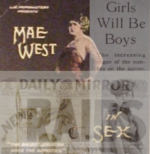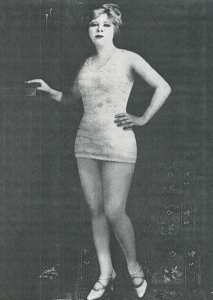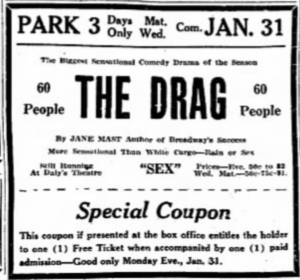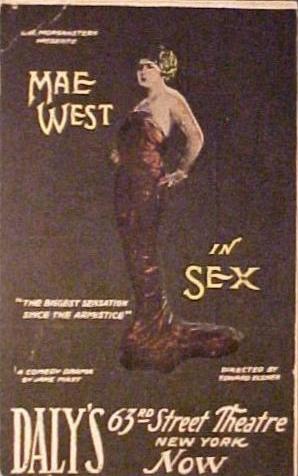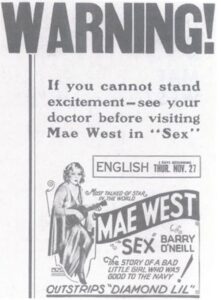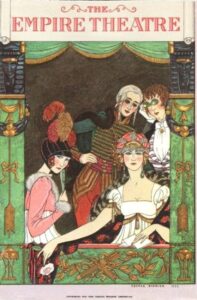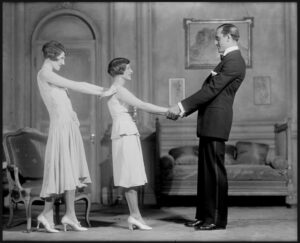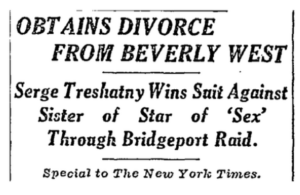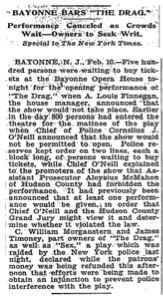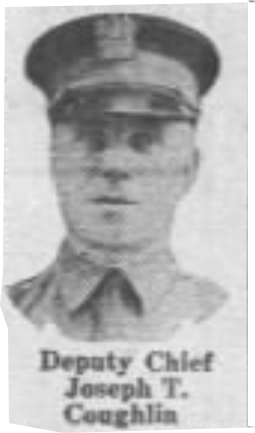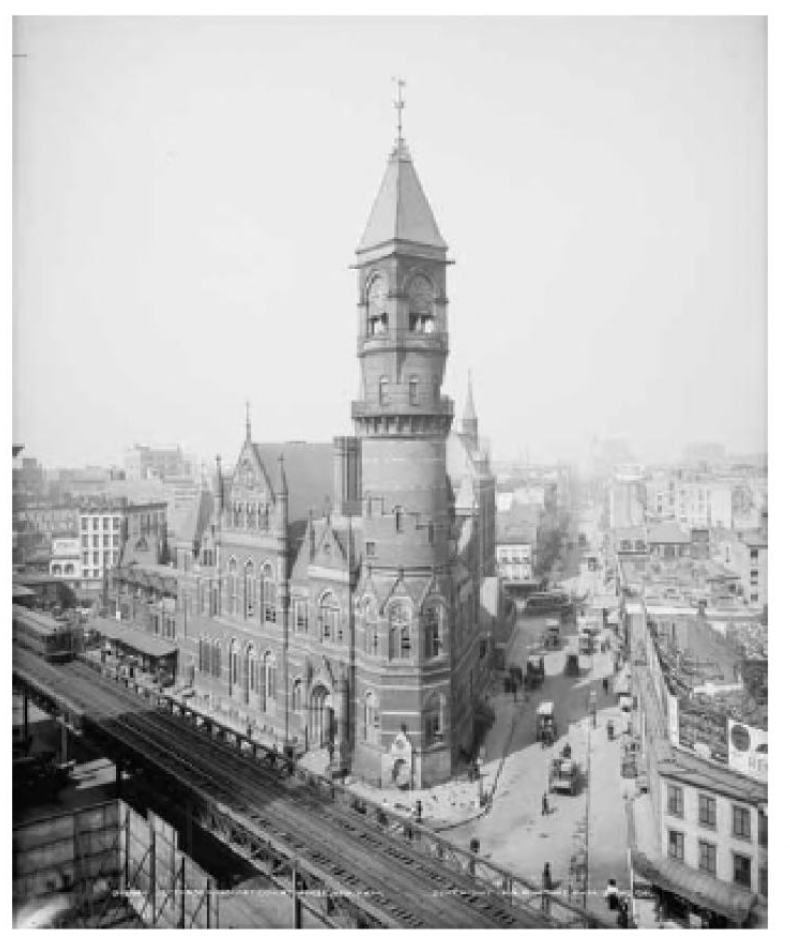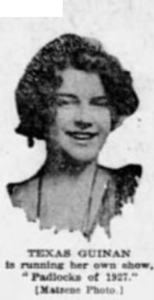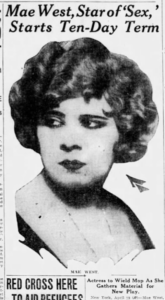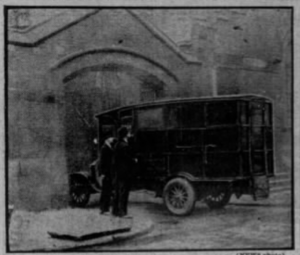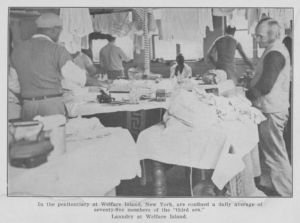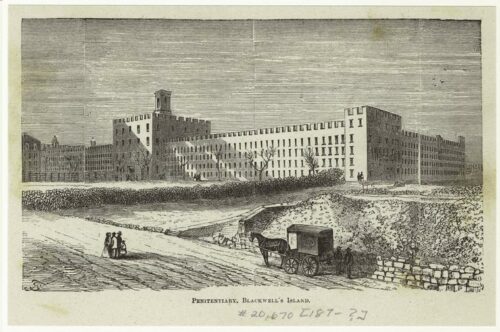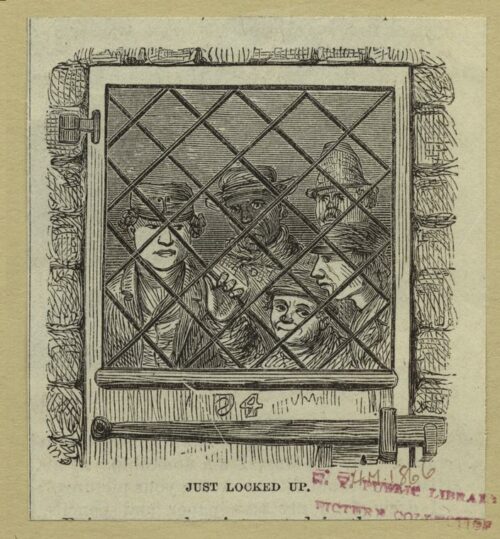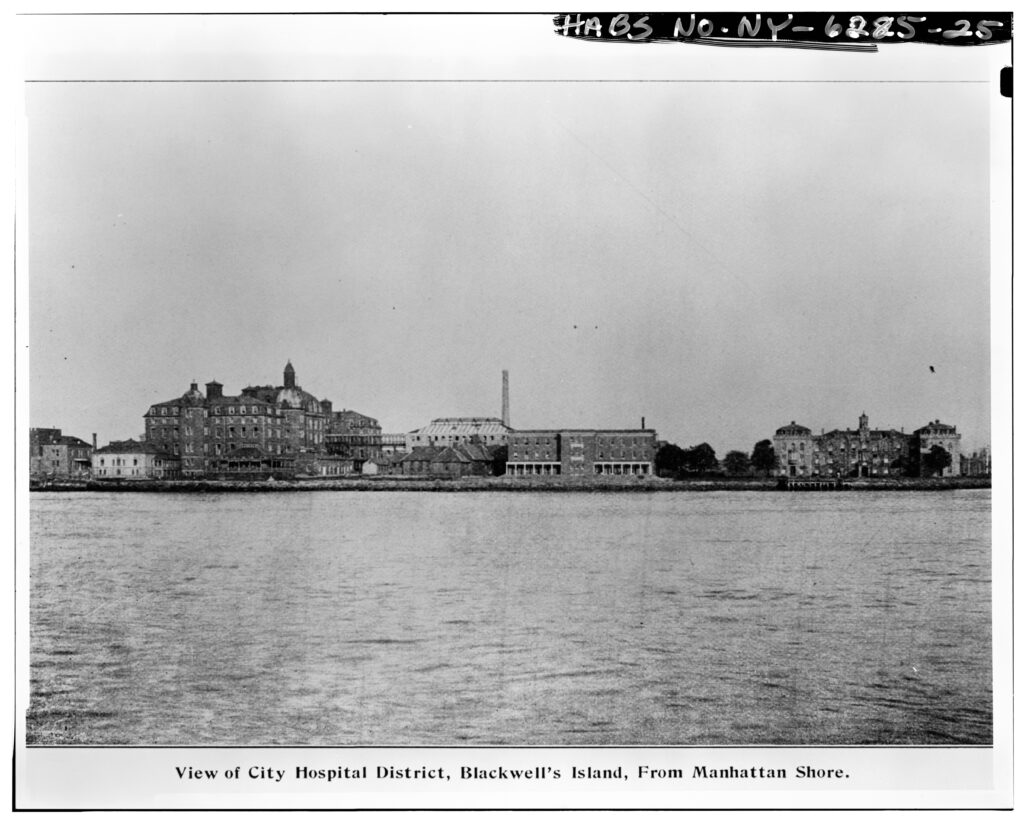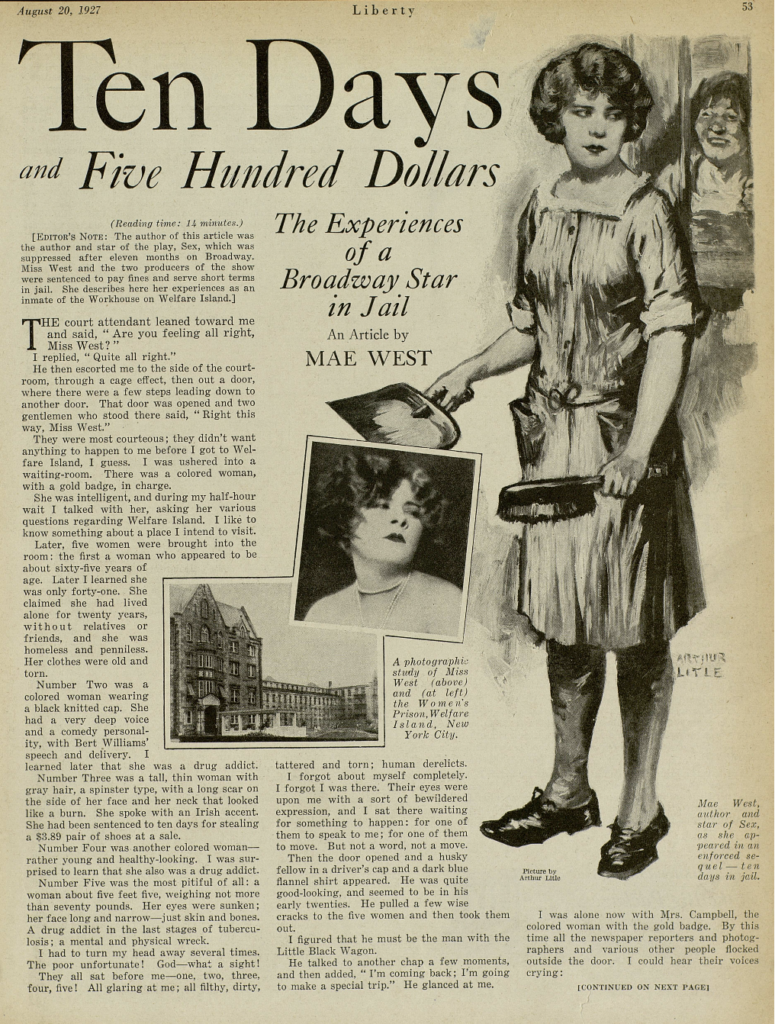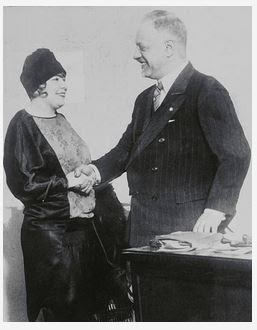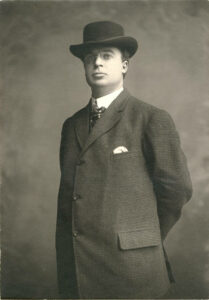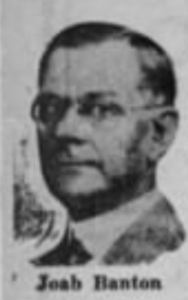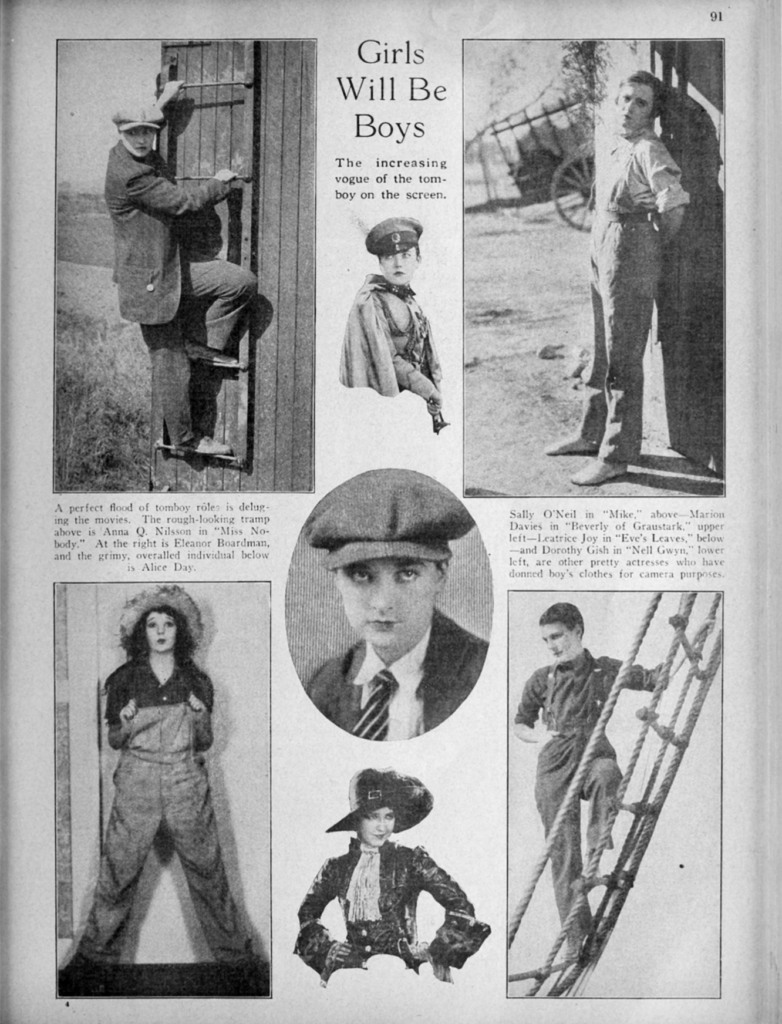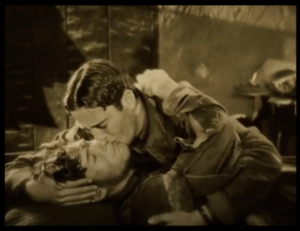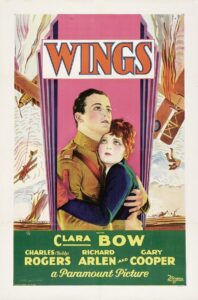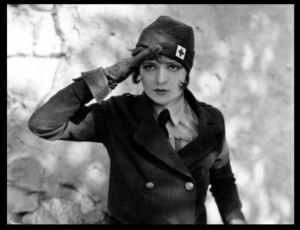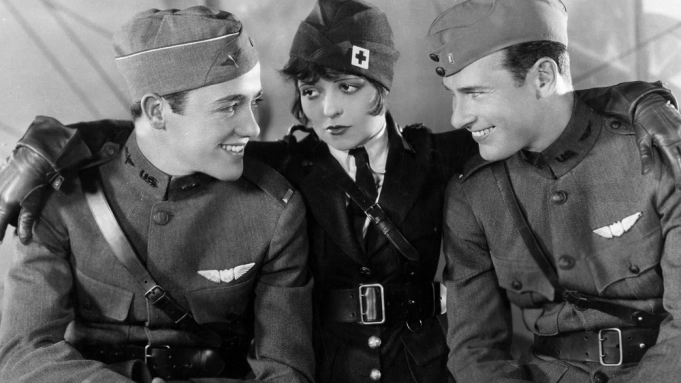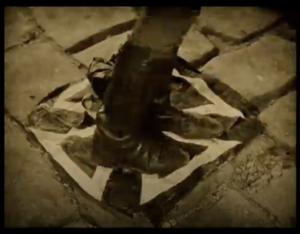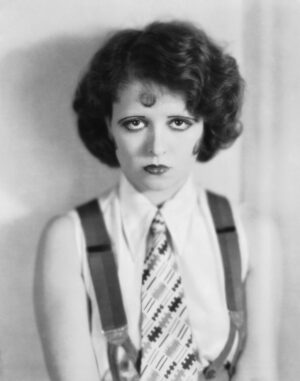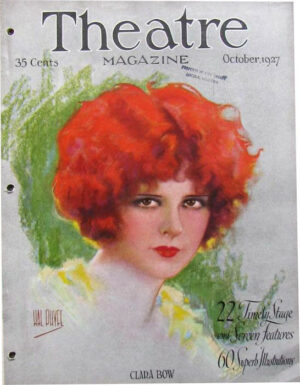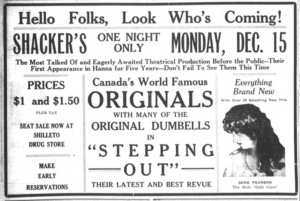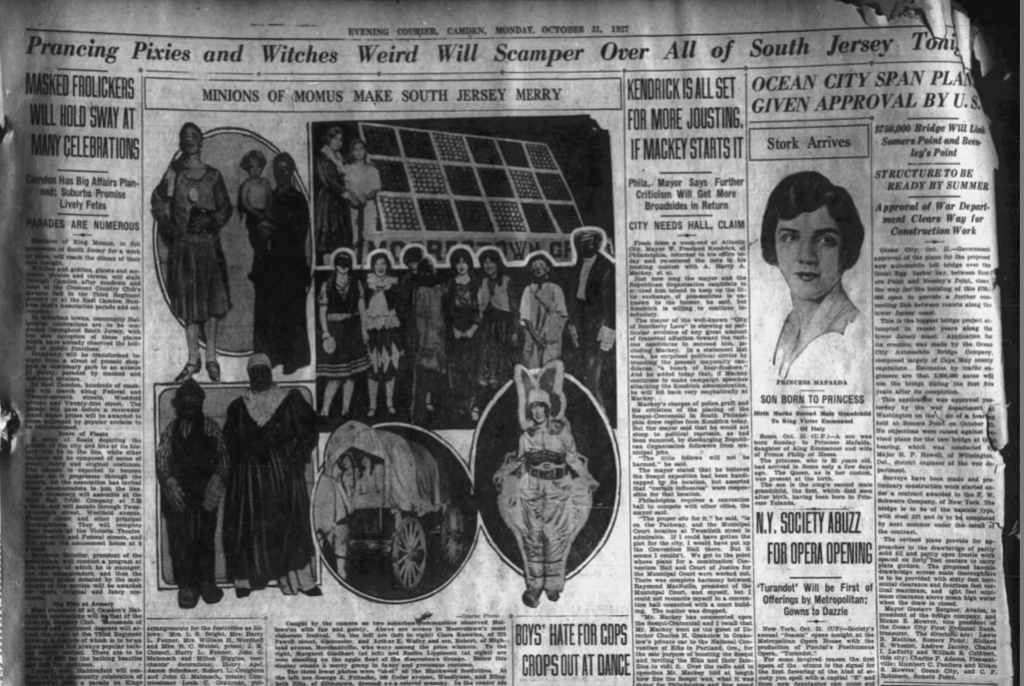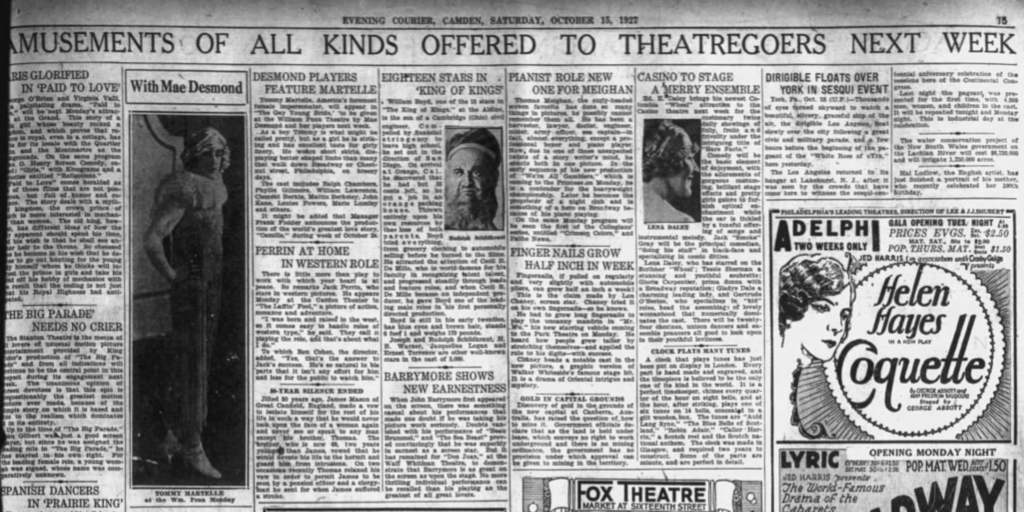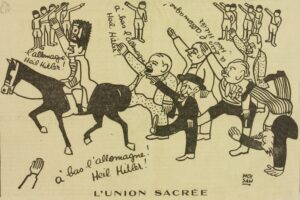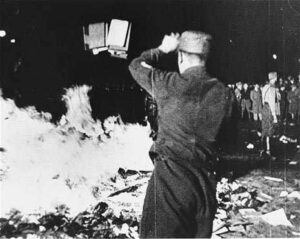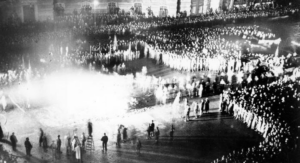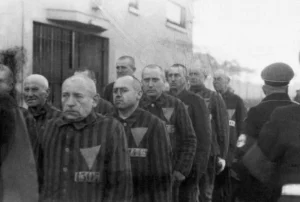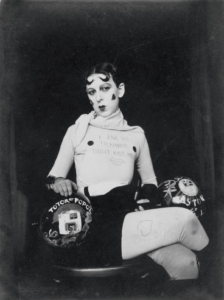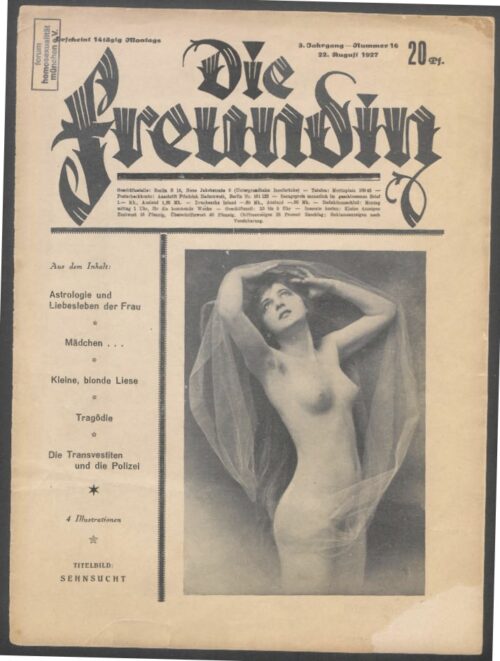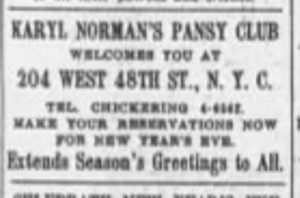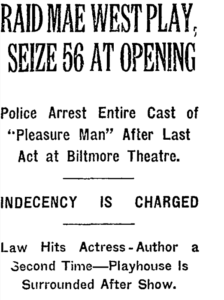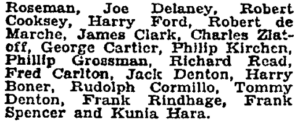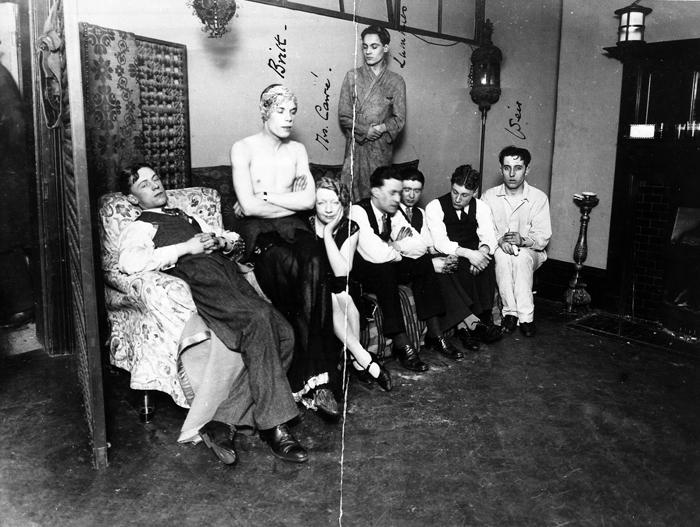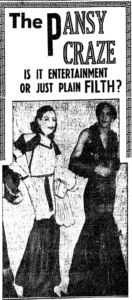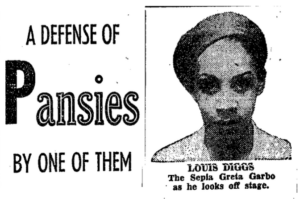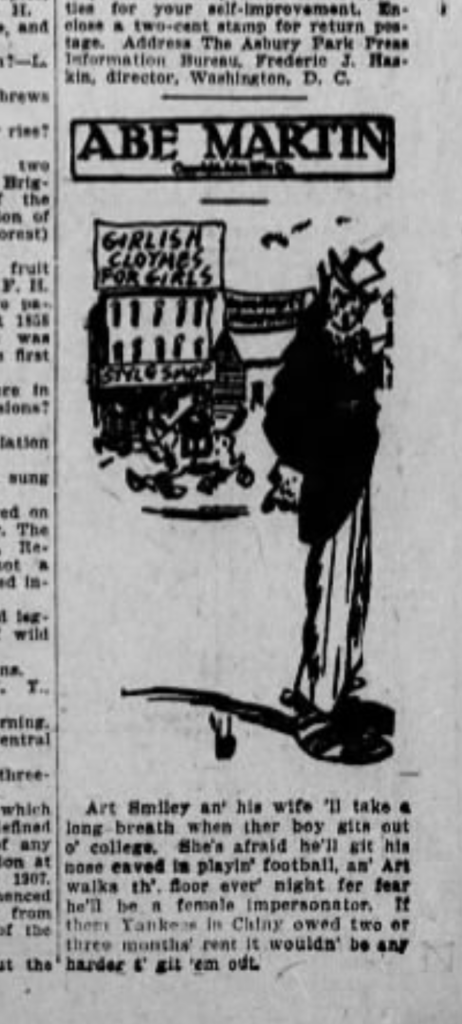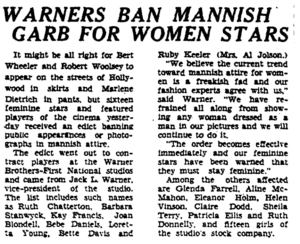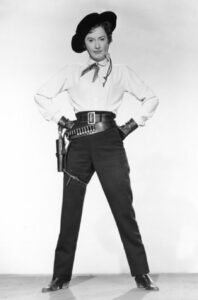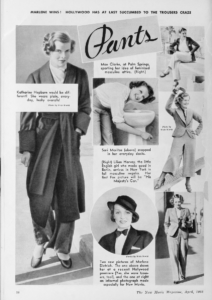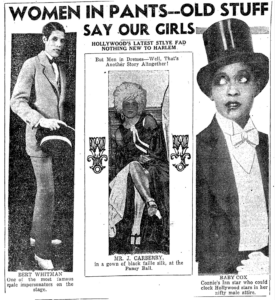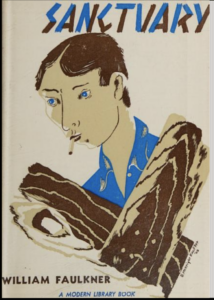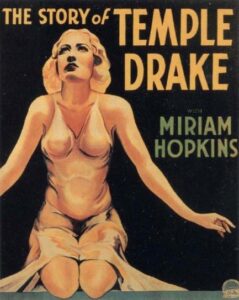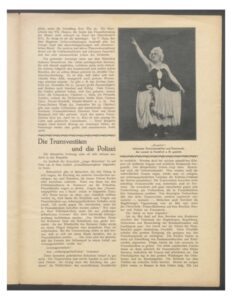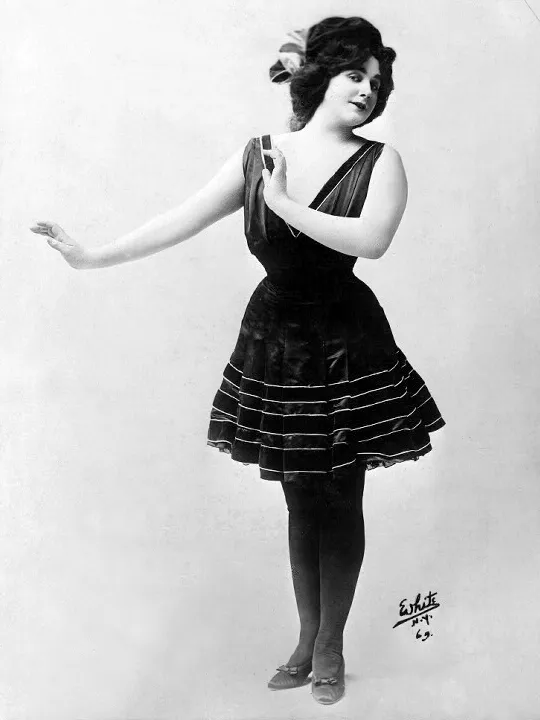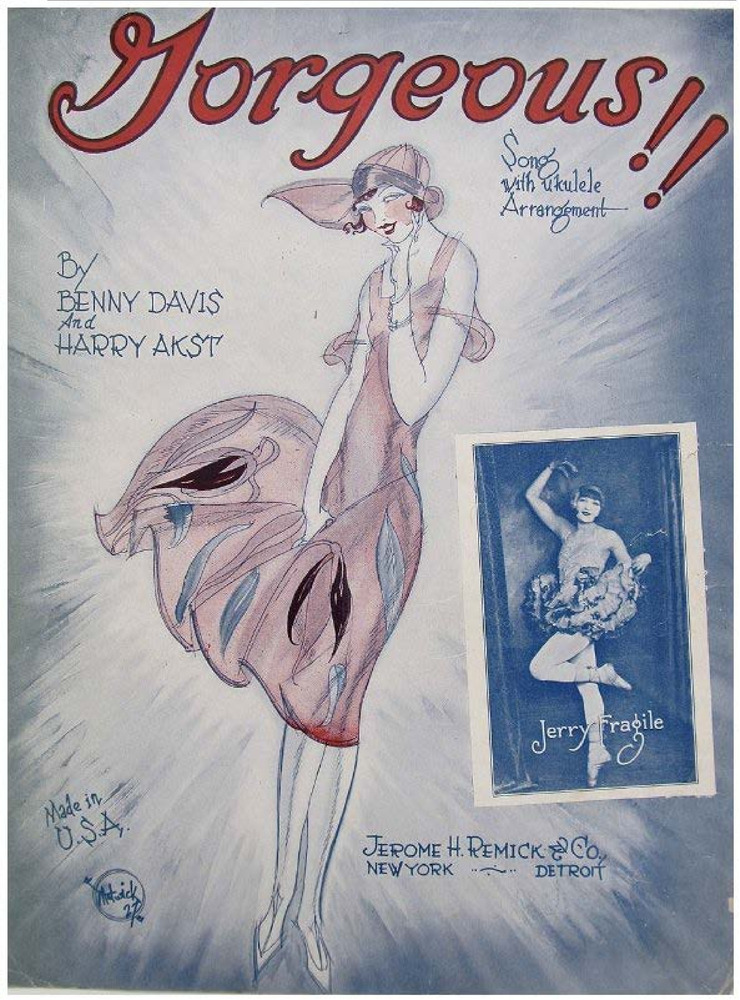
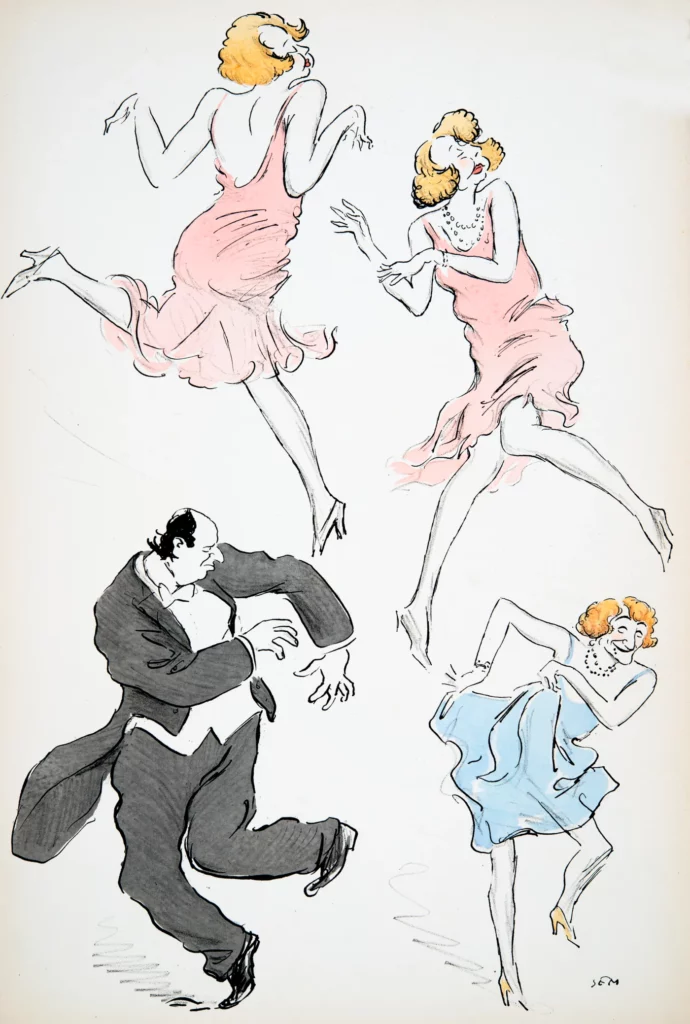
1927 was a banner year for queer representation in cinema and theater – and also the year that the progressive momentum was met with increased institutional repression, arguably commensurate with the success of LGBTQ+ rights in the era. Part of the growing fascist menace was to criminalize and persecute queer life and culture, and the same with feminist life and culture, and anything to do with sexual/gender freedom.
In particular, 1927 saw the production and theatrical debut – and repression – of a play called The Drag, written by playwright and film star Mae West, a proponent of gay rights and women’s liberation.
The play depicts a large group of queer performers “of the vaudeville milieu and of the gay life within it,” queer scholar George Chauncey explains.
Richard Helfer’s 1990 dissertation sighs, “The Drag is a frustrating play to analyse: obviously important and not very good.”
One of the only people to actually see The Drag was the Staff Reviewer of The Bridgeport Telegram in Connecticut – who was not impressed, but also not offended, writing: “‘The Drag’ is not a ‘sensation.’ It is not lewd. It is not obscene. But the question is, whether it is worth while at all.”
Another critic in the audience that night: the NYPD had sent James Sinnott up to Bridgeport to see the play, and report back on the naughty bits.
Romy Sara Shiller tells us that: “West did not appear in The Drag which played in preview performances in [Bridgeport,] Connecticut and [Paterson and Bayonne,] New Jersey in January 1927.”
And sometimes did not play. Shiller writes that “…in Bayonne, New Jersey, the police ordered a seated audience out of the theatre.”
The manager of the Stamford Theater in Connecticut “refused to permit the first perfomance of ‘The Drag’…”
At the same time, West was starring in another play she had written called Sex. Schlissel writes that, “Though Sex was prosecuted, The Drag was the play under attack.”
And it was pants, as it had been with Joan of Arc in 1431 – pants, more than anything else – that upset and obsessed the powerful.
“The Drag,” Shiller describes, “was an answer, in part, to the lauded corrective tone of a play about an affair between two women running on Broadway called The Captive … of which its star, Helen Menken, said it would provide good instruction for college women regarding the avoidance of perversion.” In other words, teach them not to be lesbians.
Scholar Chad Heap describes The Captive as “(an American adaptation of French playwright Edouard Bourdet’s La Prisonniere),” writing that “Broadway audiences encountered a young French woman whose marriage to a male friend never managed to quell her intense sexual desires for the mysterious Madame d’Aiguines.”
Shiller describes the play’s damning end: “At the final curtain, the woman who lured a young wife away from her husband was represented only by a small bouquet of violets left on a table. The word ‘lesbian’ was never uttered.”
Shiller also notes that, “The jazz band [in The Drag] … [was] openly scoffing at Helen Menken’s play about lesbians with a song by a gay chorus called “The Woman Who Stole My Gal”…
At this same time, on February 2nd, Mae West’s sister and understudy, Beverly West, was “found” in a Bridgeport hotel room with the stage director of The Drag, Edwin Elsner. The Hartford Courant reported that the affair was found out because of a presumably rowdy evening at the Arcade Hotel, between Bev West and Elsner.
Elsner had been acting in plays since the turn of the century – and was famously shot in the leg with an ancient Blunderbuss on the stage in Buffalo in 1901, in a Rust-shooting type of incident with thankfully no deaths – the show was even able to continue, as only Elsner’s pants received the shot, and though they were set afire, he managed to put it out, and continue.
Beverly West’s husband, Serge Treshatny, was the inventor of the split rudder – which helped reduce the ability of radar to detect a plane – and he sued her for divorce immediately. Months before, West had filed for a separation that Treshatny had contested.
Shiller notes West’s cultural power, and why it prompted such a repressive response: “The fact that West’s plays are not corrective in any way, that is, they do not inscribe devices to either punish the characters who deviate from normative gender or sexuality or morally shame them, is part of the outrage [against them].”
Or as Lillian Schlissel writes: “…The Drag heighten[s] questions of sexual transformations; [it] do[es] not resolve them.”
The Drag was denounced from the pulpit and then in the newspaper, by Bishop Manning of Trinity Church. The Daily News wrote that, “At the first of the mid-day Lenten services at Trinity church, Bishop Manning denounced sex literature and unclean plays. He declared that the evils could be banished from New York if those who called themselves Christians would really practice their religion.” The mainstreaming of sexual liberation for adults had gone too far for the Church.
Legendary historian George Chauncey wrote that Mae West had “moved the sort of gay act that had become a part of Times Square’s roof garden revues, dramatically expanded it, and transposed it to the legitimate stage.”
Marybeth Hamilton describes that, “West’s characters brought spectators in contact with a large and colorful in-group vocabulary organized around gender reversal and rife with specific sexual overtones.”
This is all why, as Schlissel describes it, “on February 9, 1927 … Police Commissioner Joseph B. McKee ordered the city police to raid The Captive, Sex, and Virgin Man. The intention, clearly, was to get Mae West wherever they could catch her.”
This was even after the producers had had the script censored by Police Sergeant and apparent theater-critic Deputy Chief of Elizabeth, NJ police Joseph Coughlin.
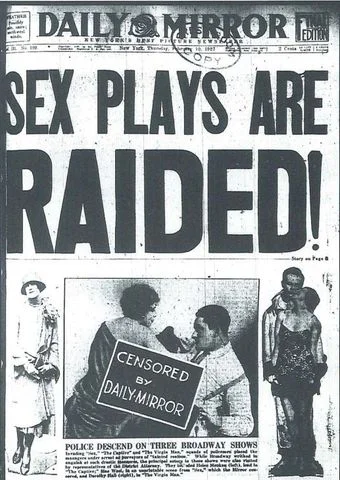
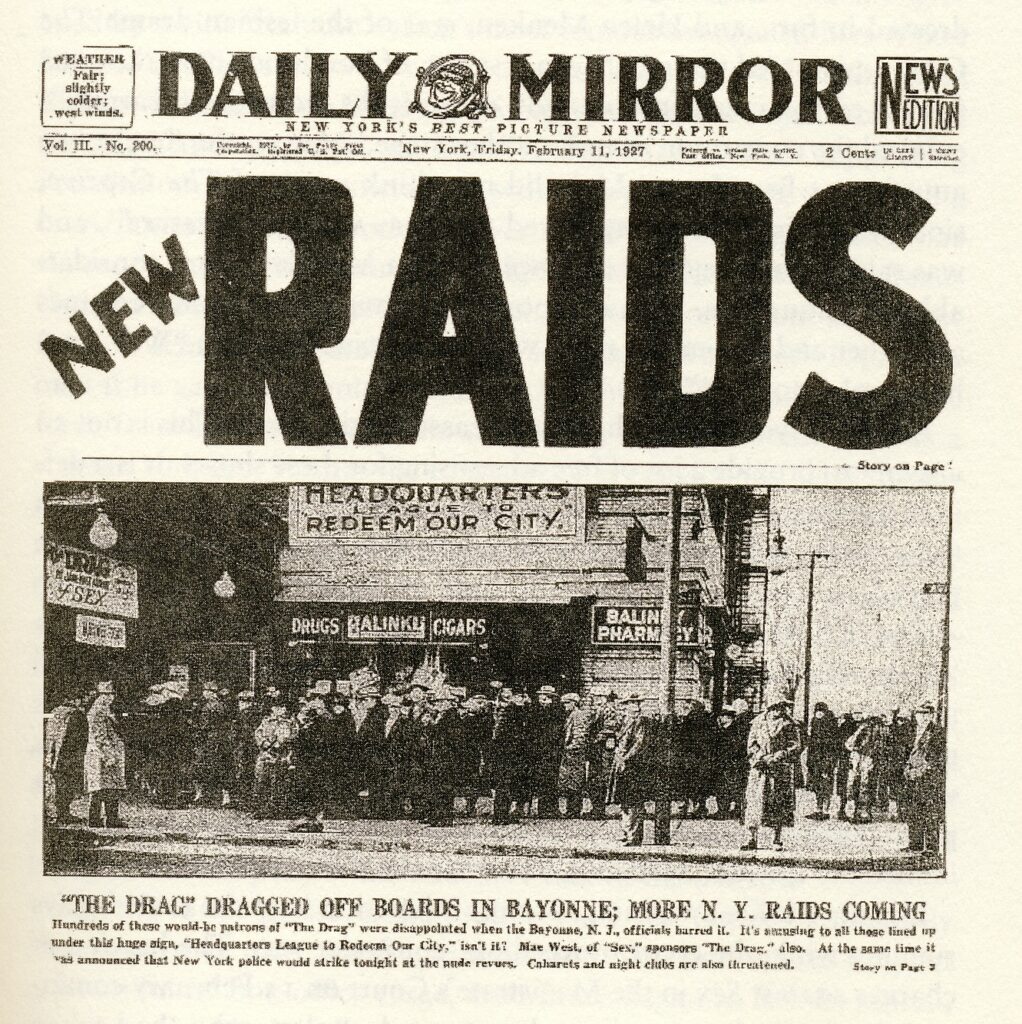
“The police raid was like a Buster Keaton comedy,” writes Schlissel. “The acting mayor sent a limousine for Helen Menken, the star of a highbrow play [The Captive.] And then he sent a Black Maria to pick up Mae West and the entire cast of Sex [after 339 performances!].”
In addition to West, 43 principal actors, 13 extras, 5 members of the orchestra, and 12 stagehands were also arrested.
“Everybody crowded into the van and then tumbled out at the Eighteenth Precinct police station, on West 47th Street in Hell’s Kitchen. At night court, West gathered her ermines and told waiting reporters that unlike Menken’s “lesbian play,” the cast of Sex were all “normal.”
After a night in the Jefferson Market Women’s Prison, West arranged bail – $1,000 for six principals and $500 each for sixteen others named in the complaint, $14,000 in all.
In response, Schlissel writes, “Helen Menken announced she would have no more to do with The Captive.
“Dorothy Hall, star of Virgin Man, was given a suspended sentence after her lawyer pled that she “had already realized the play was not what it should be, and had resigned when the raid was made.'”
“The court offered to dismiss all charges against Sex if West and the cast would close the play. They refused.”
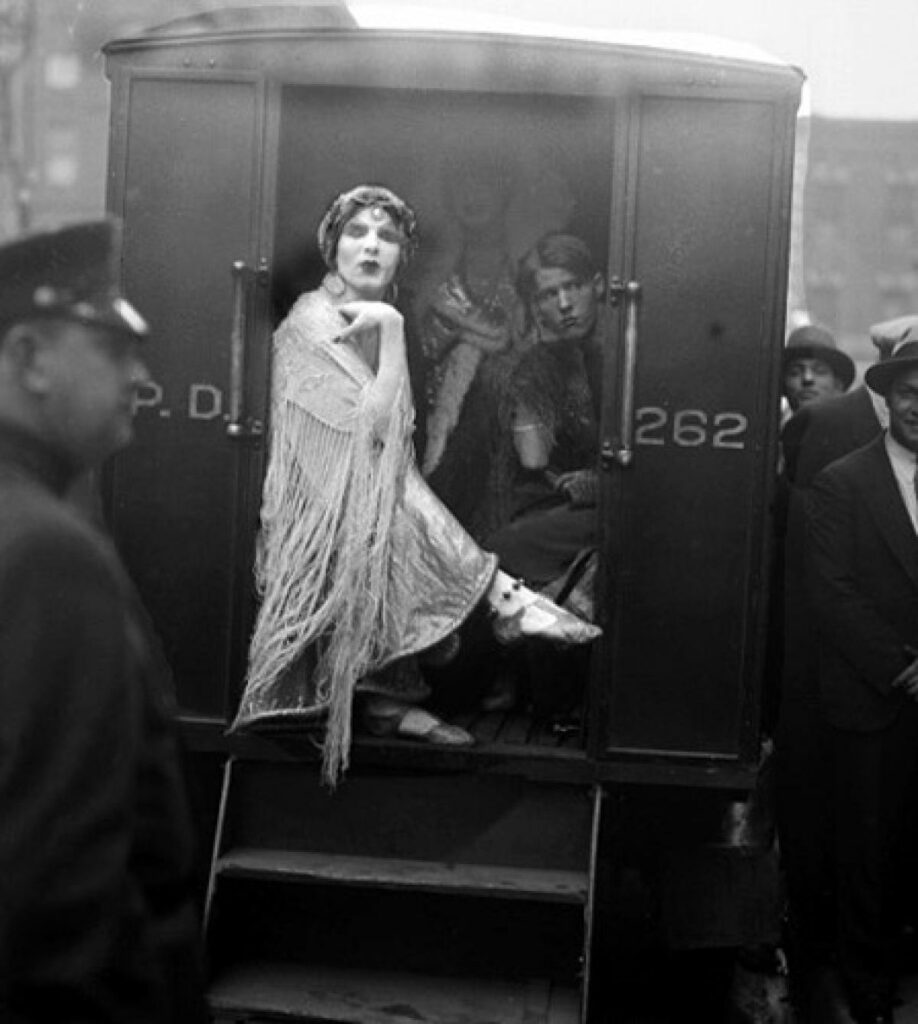
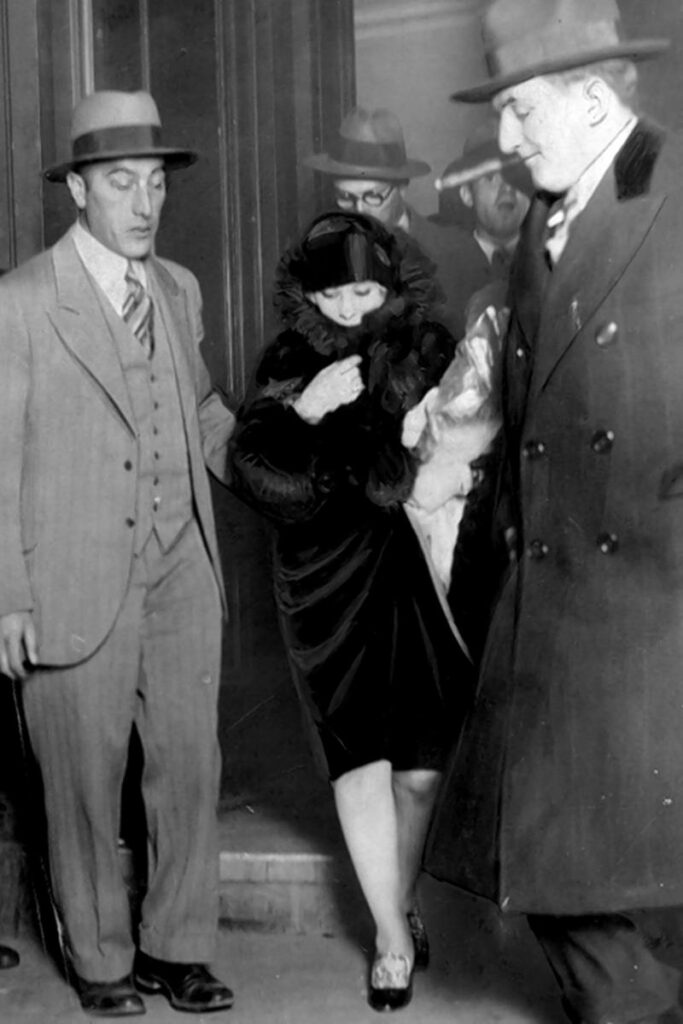
Wealthy producers and owners – in theater and cinema – feared further censorship, and largely capitulated, as they do today. Variety described that “The Drag, [was] blamed for bringing the [theater] censorship to a focus.”
This reminds one of Middle East journalist Robert Fisk, who attempted to go “off campus” from Iraq’s Green Zone where journalists were required to stay, and was scolded by another journalist not to break the rules or he would ruin it for everybody. “It” being access to the powerful.
As Mae West said herself in 1927: “… any mention of it [homosexuality] was met by ordinary people with a stare of shocked horror.”
Jill Watts describes the mood on Broadway at the time:
“…the Great White Way had hosted a series of “sex plays,” including Lulu Belle, the story of a mixed-race prostitute who slept her way to Paris, and The Shanghai Gesture, the chronicle of a madam of a Chinese brothel and her rage against men. These productions stirred a call for a cleanup of the city’s stages. As a result, career-minded actors and actresses, fearful of negative backlash, steered clear of Mae West and similar ventures.”
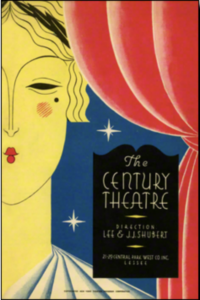
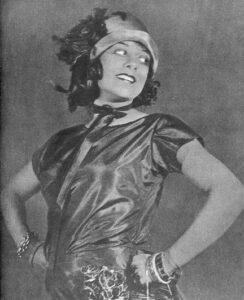
It was a ironic in-joke that West had named their production company funding Sex the Morals Production Corporation.
Schlissel describes the trial: “The prosecution provided scene by scene description of action that takes place on the stage, with specific allusions to jokes about homosexuality, to the ‘large number of male degenerates,’ to ‘sex degeneracy and sex perversion,’ to a ‘fairies convention’ and the use of the word ‘queers.’
During the trial, even producers of Sex like Harry Cohen testified against the play. Cohen used the word “kootchie” in his complaints about West’s performance.
Even after Variety published the names and addresses of jury members – adding to the pressure on them – they voted 9-to-3 to acquit.
Watts explains that after the initial jury acquital, the activist judge interceded: “after receiving additional instructions from the judge, who ruled that if any portiion of the play was obscene, the entire play must be considered obscene, they returned to the jury room.”
And they returned with a guilty verdict.
The judge gave suspended sentences to everyone but Mae West, Timony, and Clarence William Morganstern.
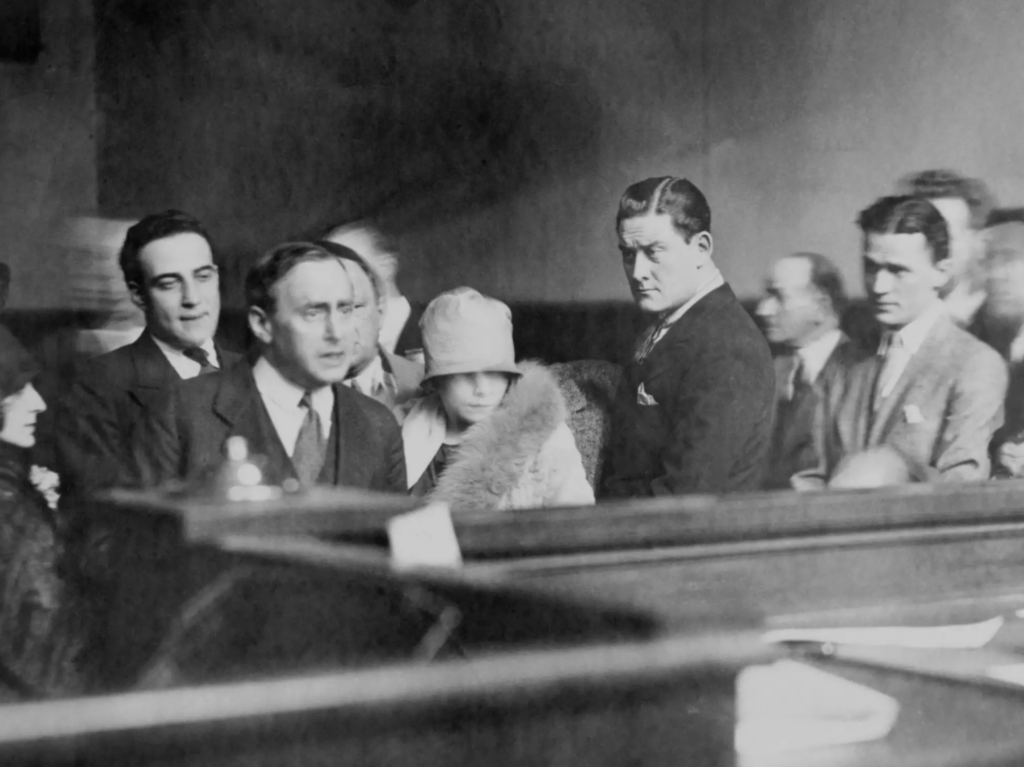
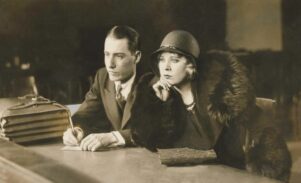
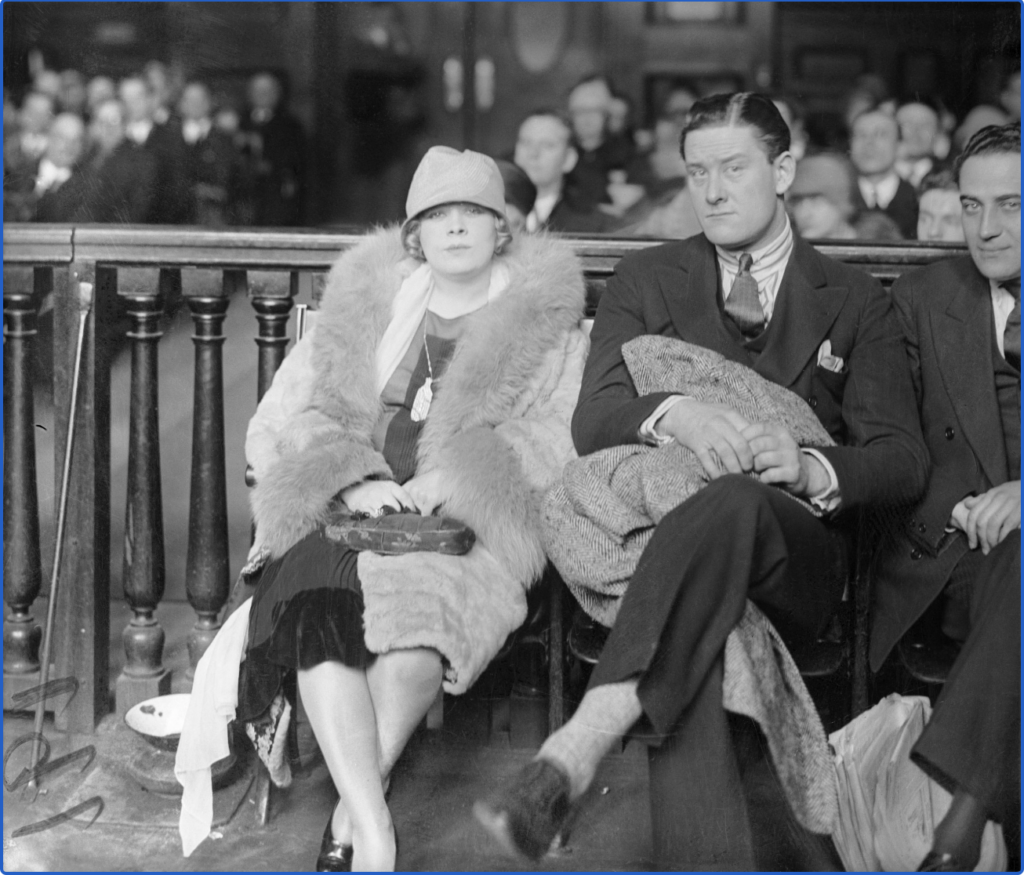
Morganstern would go on to use some of his proceeds from producing Sex to fund the musical Padlocks of 1927, starring Texas Guinan – referring to the Padlock Laws that came about shortly after Sex – the padlocks that would be put on the doors of naughty theaters so they could not make money running anything at all.
The jury found West and the others guilty after being charged “with the misdemeanor of unlawfully giving and presenting an indecent, immoral, and impure play, in violation of Section 1140A of the Penal Law, and of unlawfully doing an act which offends public decency in violation of Section 1530 of the Penal Law.”
Schlissel writes,
“West and lawyer James A. Timony, and theatrical producer Clarence William Morganstern, and cast members, were sentenced to ten-day jail terms, and fined $500 each.
“The papers reported actor James Timony breaking into tears when the sentence was announced. It is not hard to imagine the fear of an actor about to go to jail after being persecuted for association with gay and trans performers.
“The papers delighted in their sentences, running several articles about how it will be the ‘Bucket and Mop Parade For “Sex” Backers,’ closing, “Timoney has charge of a bucket brigade and Morganstern is kept busy manipulating a floor mop.”
Of course the papers also delighted in West’s imprisonment. The Brooklyn Daily Eagle ran the headline “Mae West Goes to Workhouse In Van With Two Negresses,” obviously meant to shame West for being associated with Black women, but only shames the publishers.
One random sampling from around the nationally covered story from Louisville, Kentucky’s Courier-Journal: “Mae West, Star of ‘Sex,’ Starts Ten-Day Term,” with a picture of West looking hardened and unhappy.
The Daily News delighted itself with a picture of the “drab maria” West was transported to jail in – after “West had herself driven to prison in a limousine, smiling for photographers, carrying armloads of white roses” which the News did not mention, although they prompted readers to, “Think how hot it must have been for Mae in [the drab maria]!”
“She spent eight days in jail on Roosevelt Island, then called Welfare Island – and dined with the warden and his wife…. “
Welfare Island at that time was home to many hospitals and asylums, as seen in this postcard calling it the “City Hospital District.”
“On her release, Liberty magazine paid her $1000 for an interview, and she donated the fee to establish a Mae West Memorial Library in the women’s prison.”
West was familiar with the library especially because dusting it had been part of her “light housekeeping” duties while inside.
West served 8 days of her 10 day sentence, released early for good behavior.
Advertisements for The Drag promoted it as a company of 60 performers, including the well-known:
- Elmer Grandin, who was remembered as “a distinguished actor” in a 2003 New York Post article about two teens who dug up Grandin’s remains “from Cedar Grove Cemetery in Patchogue” and “dressed up his remains and skulls of two other bodies for a creepy party.”
- Grandin had starred in Daniel Boone in 1923, and before that had appeared with The Drag co-star Marion Davies in the 1919 silent comedy Getting Mary Married.
- Emily Francis: no images of Francis can be found. We can find her on the stage as early as 1907 in the musical The Dairymaids; in 1919 she co-starred in a play called Suite 16; Francis was obviously a favorite of West’s as Francis was cast in West’s next play, The Wicked Age.
- A. Francis Lens: as well as an actor who appeared in plays with delightful titles like Too Much Johnson (1913), Lens was the Manager of the Lyric Theater Building.
- Robert Webb Lawrence: was an actor who had appeared in The House of Bondage in 1914, starring Lottie Pickford, younger sister of film star Mary Pickford.
- after The Drag Lawrence would continue in the theater in Lost and in Sinclair Lewis’ famous anti-fascist play, It Can’t Happen Here.
As the backlash against gay rights continued, New York State passed the Wales “Padlock” Law, created by District Attorney Joab Banton to “prevent shows like West’s … from ever finding a home in legitimate playhouses,” writes Ariel Nereson, who explains:
“The act included three significant changes to the obscenity laws that sought to dramatically impact the business of New York theatre. First, a play did not need to be considered as a whole, but could be judged obscene if any element of it whatsoever was found to be obscene. Second, the act banned all speech pertaining to homosexuality, and defined all discussion or portrayals of homosexuality on the stage as inherently obscene. Actors who portrated homosexuals could be arrested at any time, including in the middle of a show… Finally, and most significantly for producers … theaters that put on plays found to be obscene could be padlocked for up to a year after the conviction; thus producers would lose a year’s income…”
The Padlock Law banned displays of what it called “sexual perversion” in the theaters, which included depictions of homosexuality – thereby banning all queer theater.
This law remained in place for forty years, until 1967.
The Drag was not the only work with such representation at the time.
Indeed, the July 1927 issue of Picture-Play magazine featured this piece “Girls Will Be Boys,” describing “The increasing vogue of the tom-boy on the screen.” This page shows 7 well-known actresses of the era who had “cross-dressed” in film recently, including Dorothy Gish and Marion Davies.
Alice Day is described as “the grimy, overalled individual” – but just a few years before she was one of Mack Sennett’s Bathing Beauties.
Elsewhere in 1927, The Climbers, a lost film from 1927, featured “a betrayed woman [who] becomes a man-hating, jodhpur-wearing plantation owner.”
What Every Girl Should Know is another lost film from 1927 “in which a girl disguises herself as [a] boy to visit her brother’s side of their orphanage.”
1927 film Easy Pickings featured star Anna Q. Nilsson “cross-dressed” as a detective.
The now-lost film titled Lost at the Front, directed by Del Lord featured stars Charles Murray and George Sidney “escaping from Russia disguised as women.” At one point, “When the two friends dress as women, there is a long scene in which they are made love to by two Russian officers,” reported the Kinematograph Weekly, “which was occasionally funny but coarse in the main.”
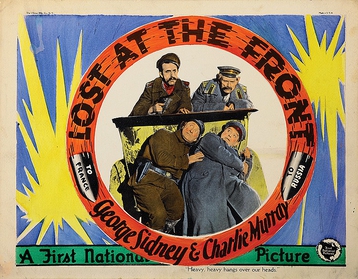
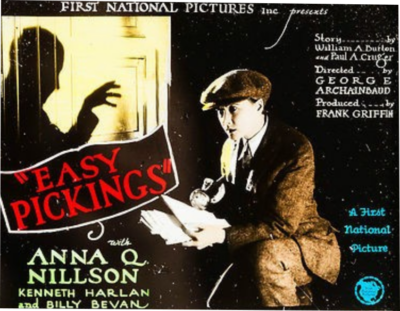
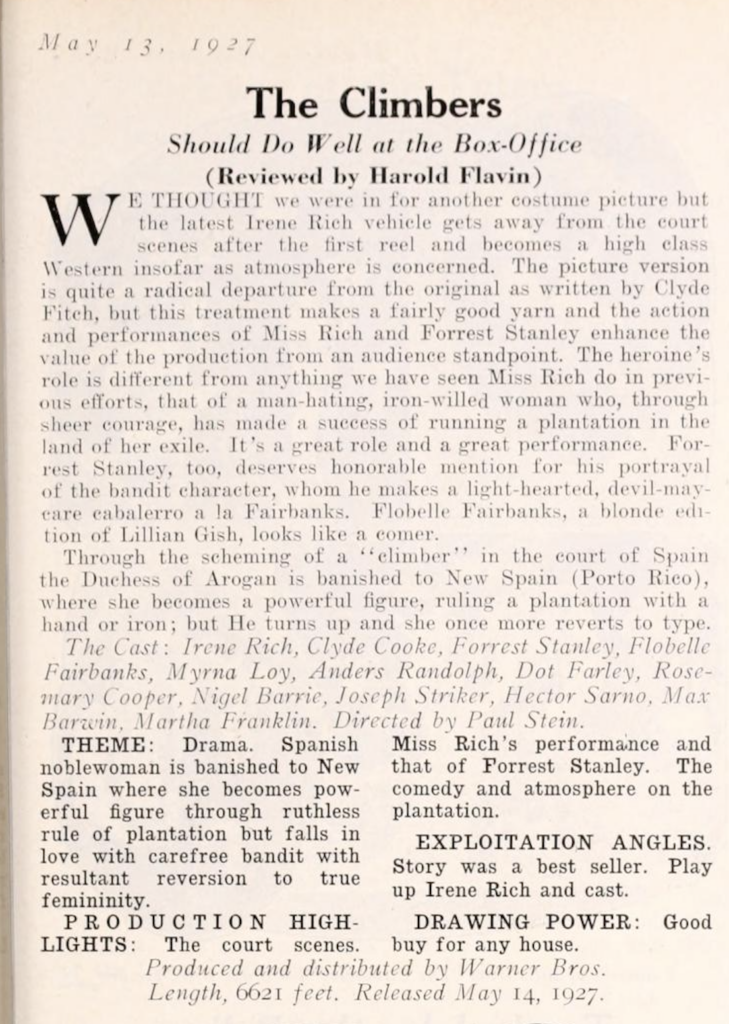
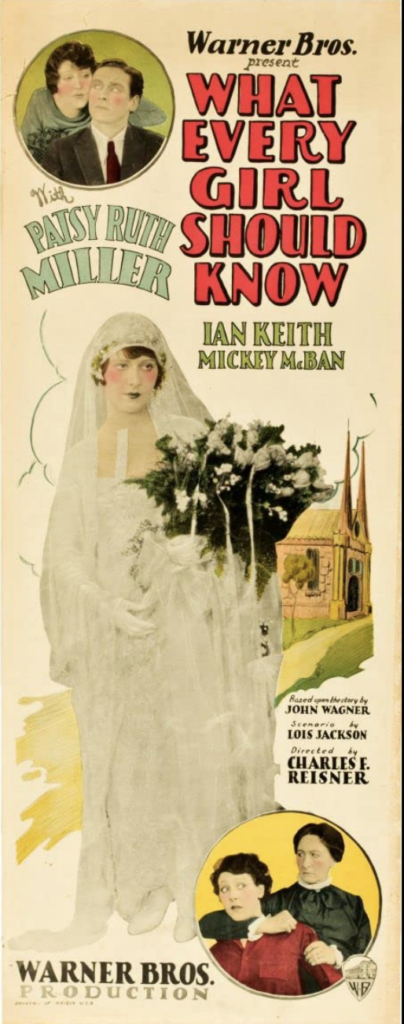
Most famously, the 1927 film Wings (not lost!) depicted what is considered the first on-screen kiss between two men. The film was widely celebrated, and won the first ever Oscar for Best Picture.
Actress Clara Bow, in the role of Nurse, has been credited as being one of the earliest representations of androgyny in cinema. Bow had displayed the same kind of look in a 1929 film, The Wild Party.
In spite of the repression, Bow’s career was not harmed by her look, and she was the cover story for the October 1927 issue of Theatre magazine.
At this same time, “female impersonator” and other trans or drag “revues” were so popular and uncontroversial that advertisements and soft media pieces were part of typical newspapers.
This advert for performer Gene Pearson appeared in a 1927 Alberta, Canada paper.
Pearson would be part of the cast that was arrested in New York City in 1928 for their performance of Mae West’s Pleasure Man.
The Camden, NJ Evening Courier reported on “Prancing Pixies and Witches Weird Will Scamper Over All of South Jersey” on Halloween night.
Or a show for Mae Desmond, the “foremost female impersonator.”
Outside the United States, representation and repression continued as well, as fascism rose in Europe.
Franz Kafka’s 1927 novel, Amerika, described this attitude as pervasive across oceans:
“… in Europe [and] in America, … matters are decided by whatever impetuous judgement the initial rage of one’s superiors might dictate.”
Chad Heap’s “Slumming” describes the culture change, and how queer culture was used by straight culture, and repressed:
“…as the economic crisis of the early 1930s deprived many men of the remaining cornerstone of their middle-class masculinity – their ability to serve as the family breadwinners – their consumer-oriented model of modern American manhood required some reinforcement. The commercialized spectacle of homosexuality that formed the centerpiece of the new pansy and lesbian craze proved effective. When well-to-do white men took their female companions slumming, they encountered the perfect counterpoint to highlight their own masculinity. Whatever complaints critics had about the appearance-obsessed American male, he was undeniably masculine, even gruff, in comparison to the stereotypically slim-waisted, limp-wristed, and often-lisping pansies who peopled the stages and audiences of queer nightspots. The distinction became even more stark in early 1933, when New York authorities enforced a ban against male performers appearing in women’s clothing, forcing the long-haired Jackie Maye to become, in the words of Zit’s Theatrical Newspaper, “the first female impersonator to imitate dames in male attire” when he appeared at the popular Lido Cabaret.”
By that time, New York City had already used a 1931 mafia-shooting at Club Abbey as an excuse to crack down on all queer clubs.
Much of this worldwide repression would come to a terrible end with the persecution and murder of thousands of LGBTQ+ people by the Nazis during the Holocaust of Jewish people, as well as the Roma people, the disabled, and many others.
After the Nazis declared its art collection “degenerate,” the Institute of Sexual Sciences in Berlin was raided by students and tens-of-thousands of irreplacable books and images were burnt.
Infamously, gay prisoners in concentration camps were forced to wear a Pink Triangle and were targeted for sexual and other abuse.
—
There are many examples of queer art created in 1927:
The famous French surrealist artist Claude Cahun created his “Self Portrait from the series I am in Training Don’t Kiss Me.”
Writing in The Oxford Handbook of Queer Cinema, James S. Williams describes Germaine Dulac’s film Invitation to a Journey: “The nautically themed bar in … featured not only female patrons in male drag, but also women clearly performing male roles, such as the policeman and the bellboy.”
Dulac’s film also features an “interracial” couple, which would have been prohibited by the New York State Padlock Law.
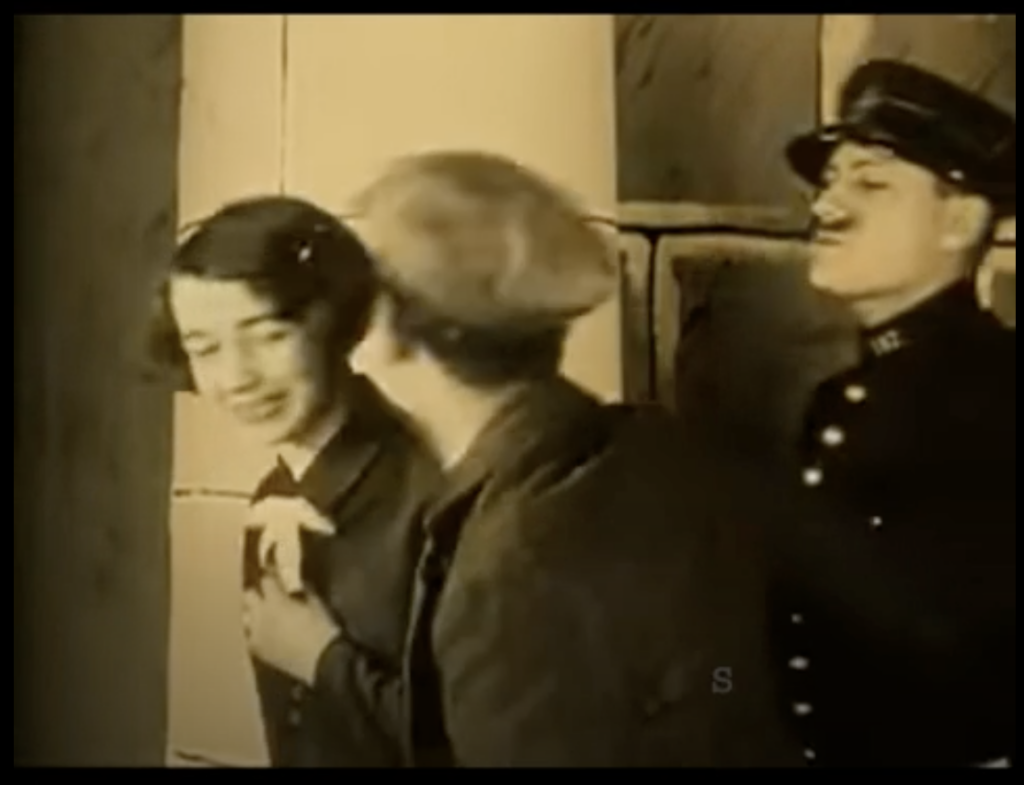
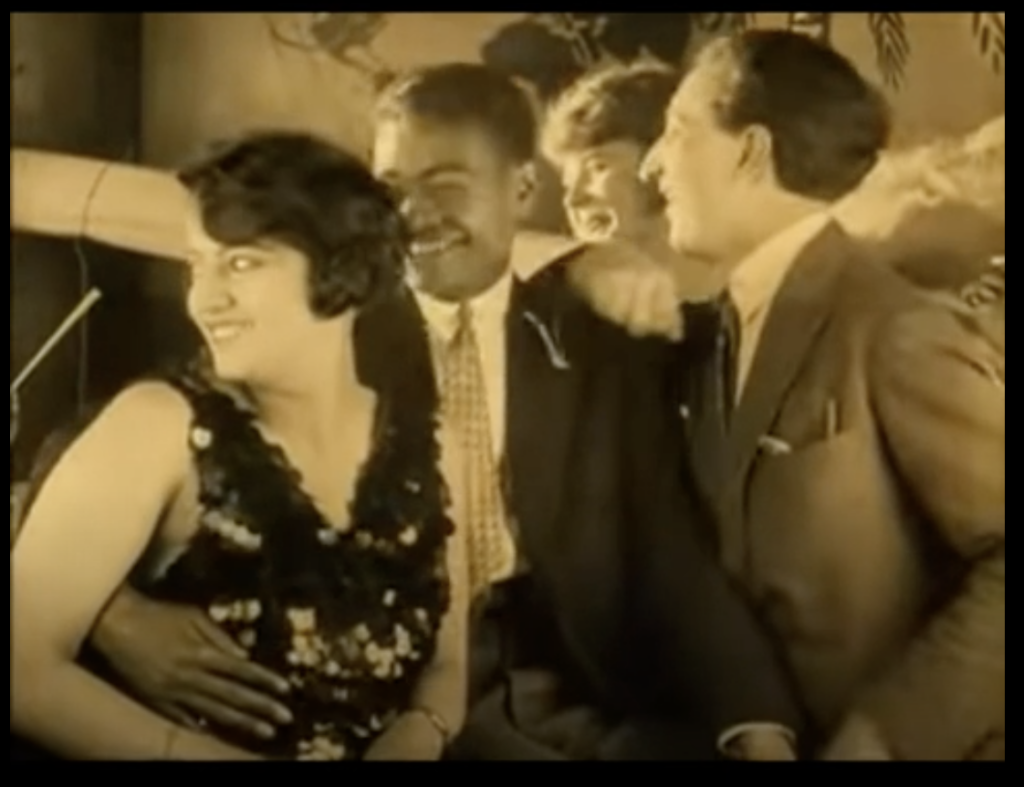
Williams also describes, “One [of the most] casually androgynous-looking characters of the interwar period include[s] Jean, the wan, fragile melancholic who stages his own suicide in front of a mirror in Jean Epstein’s Six and One Half Times Eleven…”
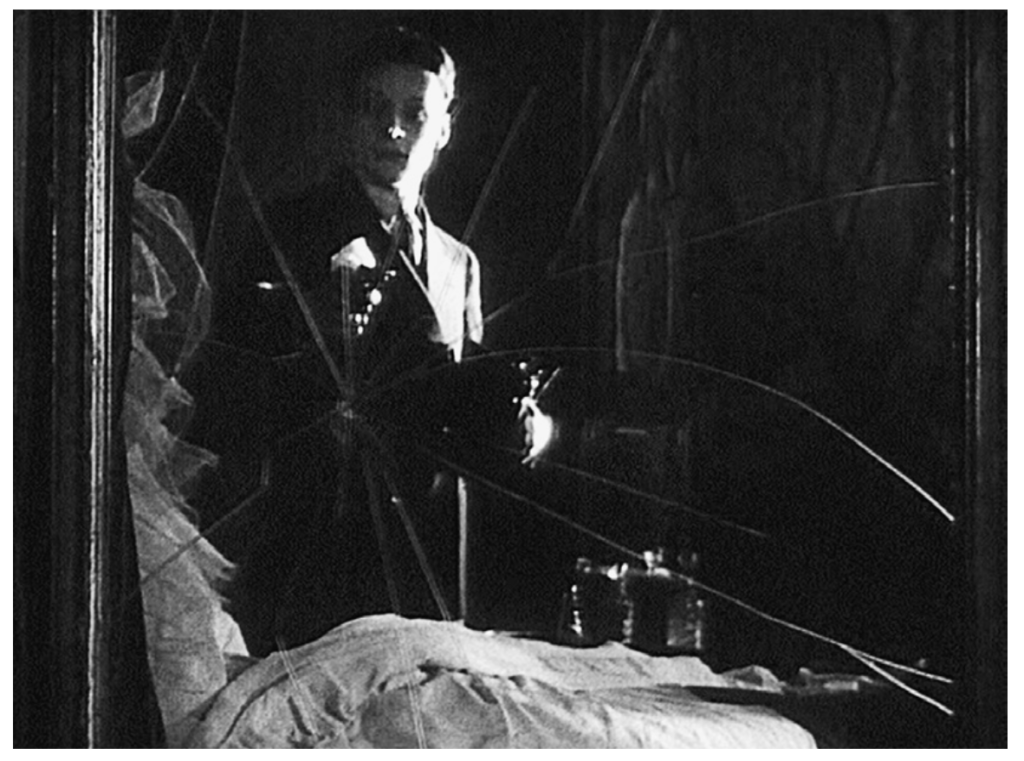
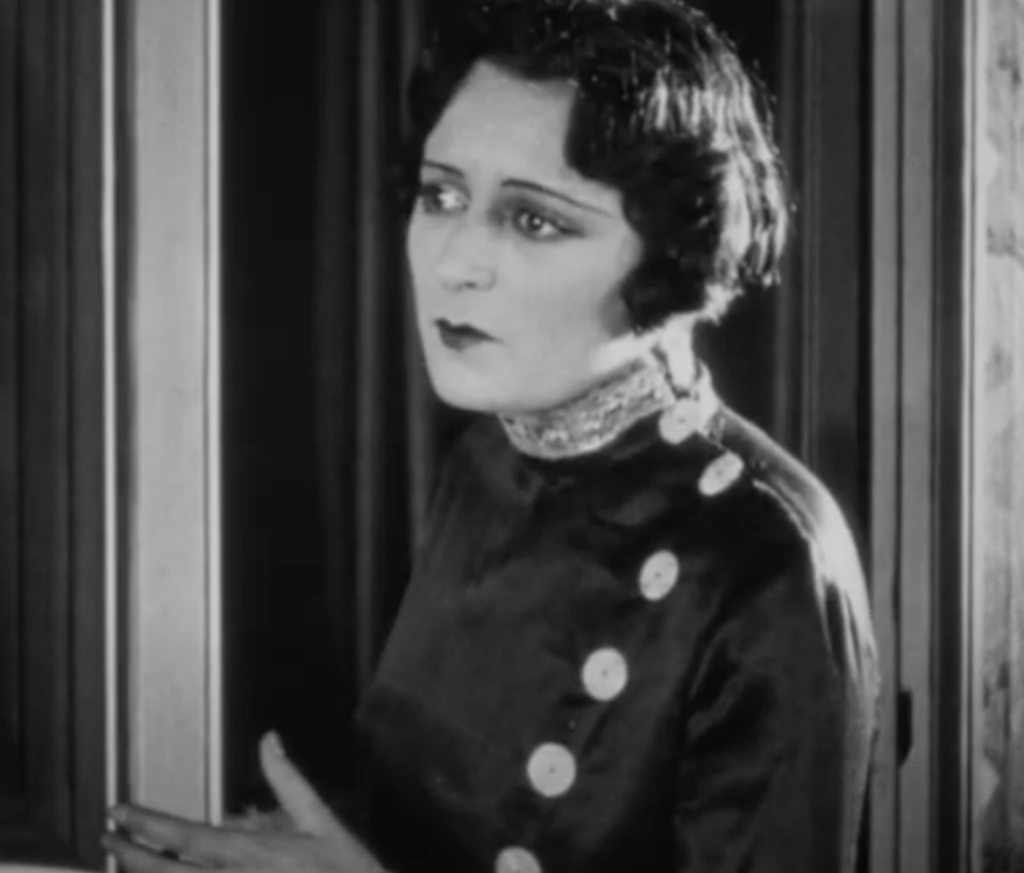
This issue of the most famous lesbian magazine of its era – the great German magazine Die Freundin [The Girlfriend] – features a cover article entitled “The Transvestites and the Police” that mockingly chides police for their repression of transgender people in the name of fighting crime, an illustration that repression remained ongoing even in eras of improvements in gay rights issues.
This issue of Die Freundin also features a picture of “Mita, well-known female actor and transvestite, who is currently living in Frankfurt.”
In the United States, the 1920s had seen the so-called “pansy craze.” As late as 1930 articles in Variety were issuing calls for “a legit musical called ‘Pansy,’ to be played in reverse by the cast, all in drag.” The producers are said to think “the public is sufficiently ‘pansy conscious’ to stand for” it.
1930 saw the opening of the Pansy Club at 204 West 48th Street, featuring “female impersonator” Karyl Norman, the “Creole fashion plate.”
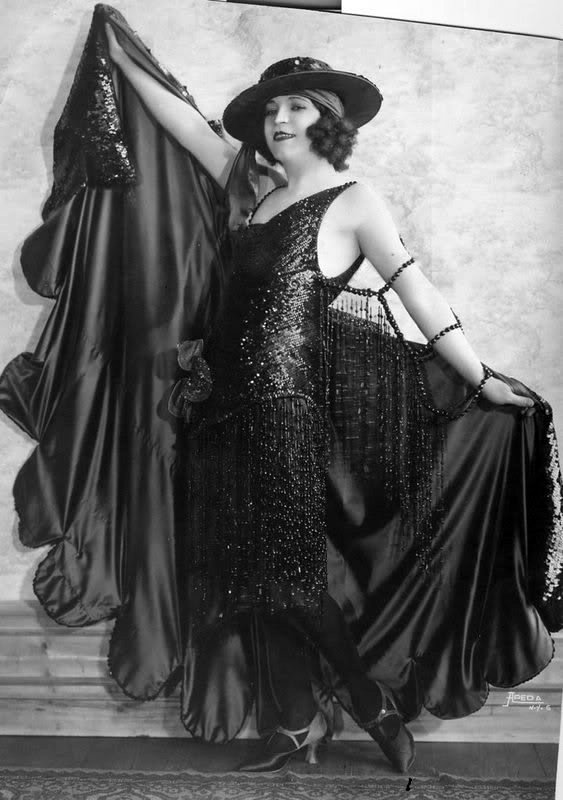
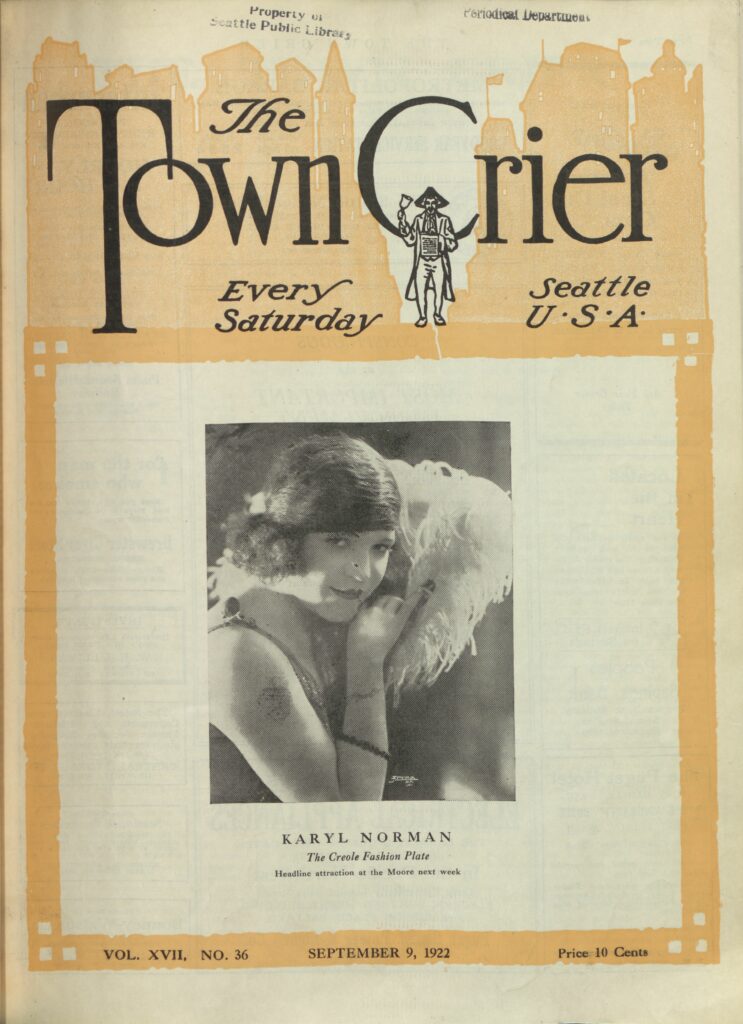
But the repression of The Drag had deep meaning, and it was followed up in 1928 by repression of Mae West’s new play Pleasure Man, for violating the Wales “Padlock” Law. The New York Times reported that:
“The entire cast … fifty-five actors, actresses and musicians, were arrested on the stage of the Biltmore Theatre, Forty-seventh street … immediately after the curtain fell on the first performance. Mae West, author of the play, was arrested and released on $500 bail a short time after … she went to the Forty-seventh Street Police Station to visit members of the cast and attempt to arrange for their release on bail.”
Appearing once again for the NYPD was famed police-theater critic James P. Sinnott, who had attended The Drag in Bridgeport, CT the year before.
Of the many names printed in the New York Times’ article as “booked” that night – including the beforementioned Gene Pearson, one wonderful light gleams brightest: among names like James Clark, Richard Read, and Fred Carlton, we come across our shining star: Harry Boner.
But throughout the 1930s, the US saw the repression and purposeful fading of the “pansy craze” which had “dominated night clubs and banquet halls in these years and taught the heterosexual public to identify, examine, and comprehend the deviant minority within its midst” and “recognize gay men on sight,” writes scholar Anna Lvovsky.
George Chauncey explains the scapegoating of LGBTQ+ people:
“As the onset of the Depression dashed the confidence of the 1920s, gay men and lesbians began to seem less amusing than dangerous. A powerful campaign to render gay men and lesbians invisible – to exclude them from the public sphere – quickly gained momentum.”
As usual – there was a political reason for this appearance of The Enemy Of The Month Club (Gore Vidal’s term). Chauncey argues:
“An investigation into corruption in New York City’s magistrates’ courts and police directed by the distinguished Tammany Hall foe Samuel Seabury had begun to posit a serious threat to Mayor [Jimmy] Walker; his newly appointed police commissioner, Edward Mulrooney, launched a highly publicized war on vice in an effort to divert attention from the investigation.
“Later that year the police moved to crack down on the city’s drag balls as well. They forced the organizers to cancel one planned for September 26 at the New Star Casino at Park Avenue and 107th Street, where several had been held the previous year, and half a dozen policemen appeared the following week to prevent a smaller drag from being held in its stead at a West 146th Street hall.
“Because of police repression, particularly at the 1938 Hamilton Lodge ball, ‘the largest drag ball of the year,’ which had been held for more than seventy years, was cancelled. “The Lodge chose not even to try sponsoring a ball in 1939, abruptly ending a seventy-year-old tradition.”
That last paragraph was for anyone who tries to argue that LGBTQ+ rights or representation is “new” and not traditionally part of the culture.
1931 saw police Commissioner Edward P. Mulrooney quoted in the Herald Tribune that “there will be a shake-up in the night clubs, especially of those which feature female impersonators.” They would be using the Volstead Act as their excuse – the Volstead Act being the Prohibition Against Alcohol Law.
Authorities were also trying to use a proposed 1 a.m. curfew to suppress the “pansy clubs.”
The Herald writes that,
“Night club proprietors in Greenwich Village said … that they would be pleased to close at 1 a.m. because their patrons come early and because they will not be compelled to pay union musicians and actors full time wages.
“Broadway and Harlem proprietors who depend on the after-theater crowds for the bulk of their patronage were despondent and resentful. They said a rigidly enforced 1 a.m. curfew would drive every night club and cabaret on Broadway and in Harlem into bankruptcy.”
In February 1931 Variety was reporting that police repression was so active that “all places depending on ‘pansy’ personalities for a draw have a cop stationed at the door to see that the room is emptied promptly at 3 A.M.”
The following part of the Variety article is chilling:
“The gendarmes [police] are also making it tough for stags to get into the clubs with anyone entering without a female in tow coming under a thorough scrutinizing, and while he is within hearing distance the cops demand to know from the headwaiter, ‘Who are those two guys sitting in the corner who came in alone?’
“With several of the [newspaper] dailies starting campaigns against the clubs specializing in floor shows featuring fem. impersonators and m.c.’s who boast of a lavendar tinge in their make-up, that class of entertainer is, it appears, about washed up for nite club importance on Broadway. …if the cops have their way the effeminate clan will hereafter confine its activities to the Village and Harlem.”
George Chauncey explains how authorities put the onus on bars and clubs to keep gay-appearing people out of their establishments:
“The genius of the [New York State Liquor Authority] licensing mechanism lay in the way it expanded the state’s ability to survey and regulate public sociability. The SLA had only a small staff of plainclothes agents to investigate the compliance of bars. But by threatening proprietors with the revocation of their licenses if its agents discovered that customers were violating the regulations, it forced proprietors to uphold those regulations on behalf of the state. Turning such proprietors into deputy enforcement agents expanded the reach of state surveillance into every establishment serving liquor in the state.
“The state legislature left the definition of ‘disorderliness’ vague, fearful, the SLA repeatedly noted, ‘lest the craft of man evade the definition,’ and it granted the SLA broad discretionary authority to interpret the restriction.
“The requirement that establishments be ;orderly’ proved to have a profound impact on gay bars. For while the legislature did not specifically prohibit bars from serving homosexuals, the SLA made it clear from the beginning that it interpreted the statute to mandate such a prohibition. The simple presence of lesbians or gay men, prostitutes, gamblers, or other ‘undesirables,’ it contended, made an establishment disorderly. An owner who tolerated their presence risked losing his or her license.”
By 1933 Billboard was reporting about a “sudden outburst of puritanism on the part of the police department [that] has all the pansy shows in Los Angeles and Hollywood folding up. Following a winter during which six pansy revues were being presented at one time, [Police] Chief Steckle has decided that Hollywood has had enough of these shows and has ordered his men to clean up the ‘boys will be girls’ spots.”
These raids saw the arrests of former child actor, now 20-year-old Bobby Gordon who was performing at The Back Yard. Gordon had been in the famous film The Jazz Singer at age 13, and went on to direct films including 1953’s The Joe Louis Story.
“When presented in court the five arrested were sentenced to the maximum of six months each in jail for masquerading in women’s clothing.”
Karyl Norman, whose Pansy Club on NY’s 48th street had seen such repression before, closed their Los Angeles club.
Billboard reported that, “Remaining pansy shows in town packed up and hopped to San Francisco, but were met by the officers during their first-night performance.”
On May 23, five “impersonators” were arrested in San Francisco at Tait’s At-the-Beach: Rae Bourbon, Neil Dorney, Jean Russell, Leonard Soules, Edye Lee and the manager, Dan Carson.
Rae Bourbon, Neil Dorney and Jean Russell were appearing in Tait’s “Boys Will Be Girls” – Bourbon being “The greatest novelty in San Francisco Nite Life.”
Three days later, on May 26, Ray Bourbon filed suit against Chief of Police William Quinn for $137 in seized goods the cops had stolen from him; and $500 in damages.
Amazingly, Bourbon would go on to be imprisoned in 1968 as an accomplice to murder. Bourbon had hired two 22-year-old men in Texas to murder A. D. Blount “in a dispute involving boarding fees for 70 dogs, five cats and two skunks.”
By 1935 Billboard was reporting about “complaints from New Orleans performers that New Orleans police are illegally arresting female impersonators playing night clubs.” They were held on “charges of having no means of honest support and being ‘dangerous and suspicious characters.'”
Illustrating that the law is always on the law’s side: the police call them dangerous and suspicious, they can end their employment, and then accuse them of being unemployed.
Such laws hearken back to the destruction of The Commons in Europe, when they criminalized not working during the daytime so they could imprison impoverished people.
Billboard continues that authorities in New Orleans had “also closed three night clubs that had female impersonator shows.”
It is extremely interesting to trace the “pansy craze” through the articles of Baltimore newspaper the Afro-American.
Through the 1920s and into the 30s, the paper reported with celebration the local “‘Pansy Ball” where “Men of Neuter Gender Frolic in Stunning Women’s Gowns” and there are “Crowds At Hall” to see them.
The articles open like this:
“The coming out of new debutantes into homo-sexual society was the outstanding feature of Baltimore’s eighth annual frolic of the pansies when the Art Club was host to the neuter gender at the Elks Hall.”
“…elaborate gowns, wraps, jewelry, pumps and lingerie…”
“This year’s ball, from a standpoint of artistic creations and ingenuity in transforming the harshness of masculine lines into the smooth contours of femininity, surpassed all previous balls here.”
“Coming out parties among the pansies take two different forms. There are the sweet young things who are just budding into flukerhood and are now ready to enjoy male companionship without being chaperoned, and those of spinster age who, after many years of dangling on the borderline of suspicion, cast discretion to the winds and blossom forth in all their glory.”
By February 1934, the newspaper was running an article about the same ball being banned by the police at the request of Howard University.
“Quite a number of the ‘best people’ were there to see the pansies dolled up in women’s clothes and were disappointed when the police would not let them enter the Masonic Temple wearing their gowns… the hecklers and police gathered around the doors of the hall … made it tough for them.”
The article then details shocking examples of abuse that night:
“…there was the pansy who was stripped of ‘her’ feminine finery and chased from Tenth and U to Twelfth and U Streets… ‘She’ had on only a jock strap and a pair of green stepins… Alden Garrison and Kitty Mae, two of the better known, came up, saw the mob, and ducked… One pansy slipped through the lines and got into the women’s rest room, but the police – the old meanies – went in and dragged ‘her’ out.”
It would be only 4 years later that Alden Garrison would die. The Afro-American reported it in an article titled “No Tears For Alden” who had “died alone and pennliness in Gallinger Hospital in Washington, DC.”
By October 5th, the paper ran the article “Is the Reign of Harlem’s Twilight Men At An End?: Pansies Losing Popularity in Nite Spots.” Without one mention of the years of open police and government and mob repression, the article straight-faced claims:
“…it appears that the pansy honeymoon is over.
“Nowdays … it is a rarity to find the undecided lads in the night spots. There are a few still hanging around, but apparently night club operators no longer think that their doors would automatically close if they did not have at least a dozen of the queers about as they did last season.”
Again, without noting any of the years of repression, the article claims:
“The truth is, the novelty has worn off. Most of the pansies had nothing to offer in the way of talent and merely depended on just being queer to put them over, but the public is demanding more than that this season. They are no longer willing to pay their dough just to see a man in a dress who would look much better in a pair of overalls. … It is no longer popular just to be a pansy.”
One day later, the same newspaper was running the article “The Pansy Craze: Is It Entertainment Or Just Plain Filth?” which tried to hide it’s bigotry by claiming they did not mind female impersonators who were talented, but despised the “slew of upstarts who have nothing to offer in the way of talent, whose only claim to fame is a freakish indecency which offends the finer sensibilities [and] is an abominable creature who should be tarred and feathered for his audacity.”
The article also openly states the reason for all this repression: “Freakishness is on the increase because it is no longer a secret sin. It is on the increase because the stamp of public approval has been placed on a thing that once meant social ostracism.”
This article featured a picture of two such people: Louis Diggs and Boots Lavada.
The next week’s issue of the newspaper featured a written response from Louis Diggs, in which she details a terrible childhood of ostracism from a time before she knew her own sexuality – but everyone else did. Diggs writes:
“As a child, there was always some phase of character or personality that struck an effeminate note in the minds of my associates and school-mates. I could never understand what impressed them to think of me in such a manner. …in the opinion of my schoolmates I was branded something that I was yet to understand.”
Then Diggs relates a cruel event:
“The schoomates’ childish accusations met with satisfaction when, as I graduated from junior high school, the teachers in charge presented me with a doll and verse which expressed effeminacy.
“I shall never forget the heartbreak this … imposed upon me.”
Then Diggs celebrates their heroism by doing what so few can do – accepting themselves:
“I resolved within myself that I would accept my fate as it was and find consolation in some channel that it offered. So in these few years I have developed into a Louis Diggs that I alone have created – and to a generation that would have me no other way, myself and others … have no regrets…”
A similar article about Karyl Norman appeared in the Illustrated Daily News in early 1933 – right before the repression reached its club-closing queer-arresting zenith.
Norman tells her story about constantly being called “Sissy!” – what the paper calls “an opprobrium that makes him tear from his body the soft feminine things he wears and with masculine vigor sock his accusers.” Norman relates being mocked by the school boys for being able to hit a High C – Brian Wilson from The Beach Boys suffered a similar mocking-hate from the boys.
In the interview, Norman also mentions the most recent issue of The Saturday Evening Post featuring Joseph Hergesheimer’s article “Good-By, Europe” where he disparagingly details trans people he is confused by in Europe:
“I continued to gaze with surprise at men dressed in all the hues of brilliant parrots. I speculated seriously about severe girls indiferent to both life and men.
“…I realized that it was not always possible easily to distinguish the girls from the men: The severe heads of the girls, their dress, the vivid colors that clothes the men, largely destroyed the customary and traditional differences in their appearance.”
Repression in the theater went hand-in-hand with repression in the cinema, and representation, when not in the hands of those being represented, can often go far astray from the humanity in the best of cinema.
Unfortunately, writes Maggie Hennefeld in The Oxford Handbook of Queer Cinema,
“…the trope of female cross-dressing … often functioned to reinforce American nationalist ideologies of pure womanhood, virile youth, and white supremacy. …the image of women in drag was instrumental to the film industry’s own campaign for middle-class respectability and moral legitimacy.”
This can be seen in the mainstream use of homosexual characters to teach lessons, or titillate, often both. For example, Buster Keaton’s 1928 film Steamboat Bill, Jr. has Keaton as the gay-seeming man no one would want for a son-in-law.
Or see this common comedy column from May 1927, in which a father’s fears for his son at college is the “fear he’ll be a female impersonator.”
Laura Schlissel writes,
“On February 17, 1933 … for the first time in … United States [cinema], female-to-male cross-dressing was singled out as a dangerous practice … the Los Angeles Times reported that ‘sixteen feminine stars and feature players of the cinema yesterday received an edict banning public appearances or photographs in mannish attire.'”
The edict was from their producers – rich men like Jack Warner – who in the 1940s “take the lead in antifascist filmmaking.”
The article quoted the edict from Warner: “We believe the current trend toward mannish attire for women is a freakish fad and our fashion experts agree with us.”
The edict was sent to stars including Barbara Stanwyck and Bette Davis – as well as “fifteen girls of the studio’s stock company.”
Laura Horak notes that Stanwyck “later made a career of playing butch frontier women” – and also points out this collage of actresses wearing pants, in the April 1933 issue of New Movie Magazine, just two months after Warner’s edict.
This wave of hatred against queer people, targeted at the arts, was not new even in those bad old days.
In 1583, puritan, publisher and gentleman Philip Stubbes wrote about the English theater and the practice of men playing women:
“The Law of God very straightly forbids men to put on womens garments, garments are set down for signs distinctive between sex and sex; to take unto us those garments that are manifest signs of another sex is to falsify, forge, and adulterate, contrarie to the express rule of the word of God. Which forbids it by threatening a curse unto the same.”
Back to 1927: The Hollywood Reporter announced the Screen Writers’ Guild, and the Writers’ Branch of the Academy, were having a “War On Filth,” citing the “baneful effect … perversion … has had on the stage.”
In a classic example of censorship inciting self-censorship, the writers “have no hope that the Hays organization can or will do anything to stop” perversion in cinema.
“The Hays organization” refers to the Motion Picture Production Code – or the Hays Code, named for Will H. Hays, who was kind of like the commissioner in the NBA, but over Hollywood. The Hays Code dictated rules by which Hollywood studios would abide, in an effort by the industry at self-censorship.
An unnamed “prominent screen writer” is quoted calling William Faulkner’s novel Sanctuary a “dirty book,” complaining that Paramount “is making it under [the title] The Shame of Temple Drake” and advocates blacklisting Faulkner, before listing recent films they think are perverse, including:
“…Sailor’s Luck,” with ‘pansies’ all through it.
“There is the Lesbian dance in Sign of the Cross.
“There were Our Betters
and the ‘nance’ cook in Hell’s Highway.”
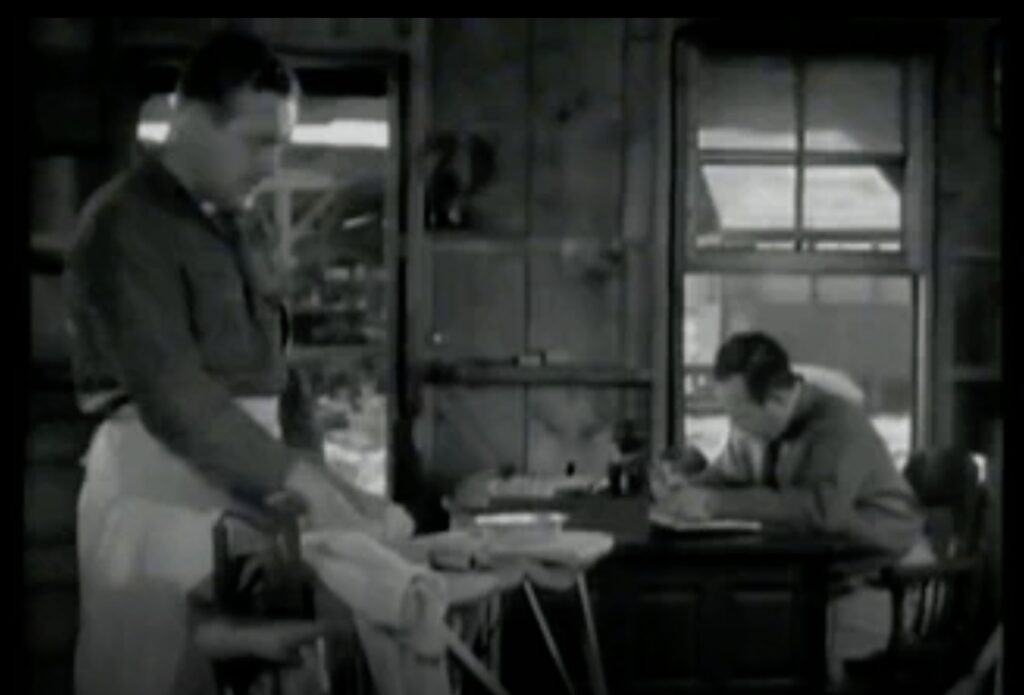
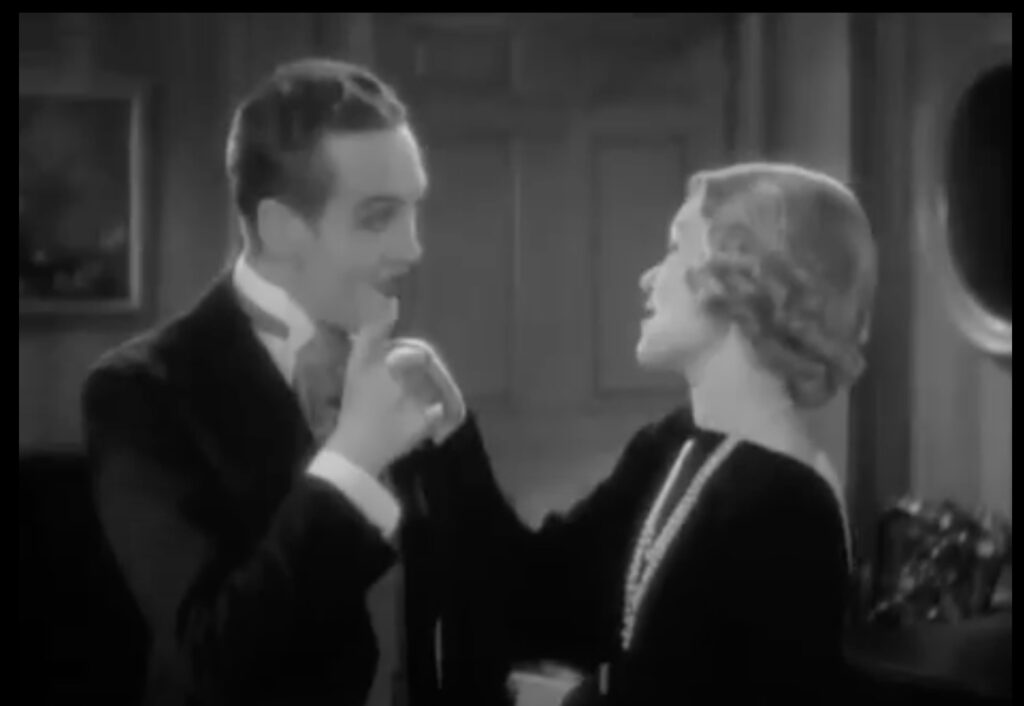
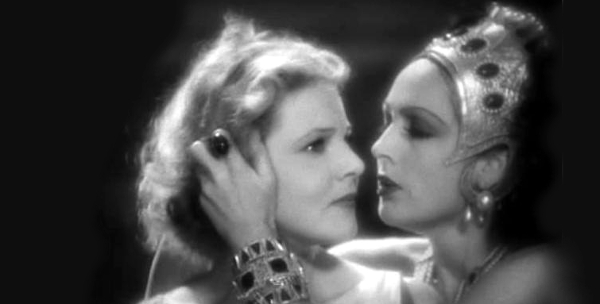
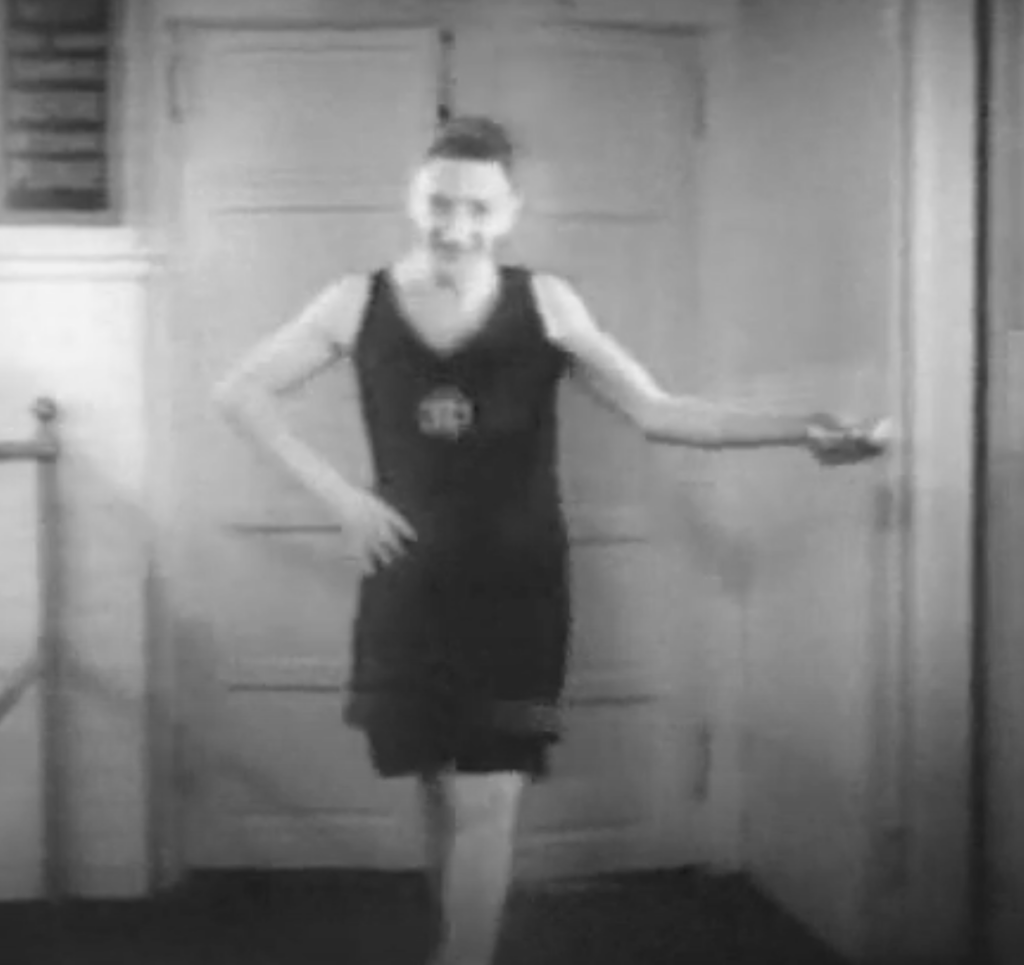
This issue of the German magazine Die Freundin, is rife with the kind of easygoing pedestrian love for others that is so missing from mainstream culture, writing,
“It is well known that there are people who have the urge to put on the clothes of the opposite sex; these are harmless people who do not infringe on the rights or interests of any third party.
“Her urge to dress for the ‘other’ (actually: the actual) gender is natural.
“The transvestites do not necessarily have to be homosexuals, they are by no means perverts. They protest very resolutely against being confused with criminals who carry out their outrages in women’s clothing.
“The transvestites standing on the sidelines, however, may see from this how necessary it is to have their own organization in the fight against false public opinion.
“We transvestites thank the authorities for protecting us from criminals who damage our public image in the most serious way. Good luck to the ‘female’ … police and have fun!”
It is both depressing and elating to know of the vibrant queer culture that demonstrably existed before the 1930s fascist destruction, reverberating to this day. So much lost, so many gains that have to be re-gained. But it was there – always there – shining in the darkness, the darkness like always refusing to see.
And one last gem from 1927, a year when one could still attend the Hamilton Lodge Ball drag ball in New York City, going strong after more than a half-century; or the wildly popular Pansy Ball in Baltimore – a year when the wave had crested but not broken (to borrow from Fear & Loathing):
Virginia Woolf’s To the Lighthouse:
“The very stone one kicks with one’s boot will outlast Shakespeare. His own little light would shine, not very brightly, for a year or two, and would then be merged in some bigger light, and that in a bigger still.”
end
This is a much longer text version of a short film submitted for Internet Archive’s Public Domain Day 1927 contest.
TLDR: Fascists repeatedly try to destroy queer culture, throughout time. Some fight back, some go along.
Some sources used:
- Chauncey, George. Gay New York: Gender, Urban Culture and the Making of the Gay Male World, 1890-1940, Basic Books, New York, 1994.
- Helfer, Richard, Ph.D. Mae West on Stage: Themes and persona. City University of New York, 1990.
- Horak, Laura. Girls Will Be Boys, Rutgers University Press, 2016.
- Schlissel, Lillian. Three Plays By Mae West, introduction. 1997.
- Williams, James. S. “Looking Through the Rearview Mirror: Queer Interzones in French Cinema, 1895-1945.” The Oxford Handbook of Queer Cinema, 2021.
- Digital Trans Archive.
